The Indian state of Assam is truly a paradise for bird watchers. As per Government of Assam, Department of Environment & Forest’s official website, the state is home to 950 species of birds out of which, some are endemic to the region. Here is a random list of 201 very beautiful birds of Assam, both resident and migratory.
-
Abbott’s Babbler
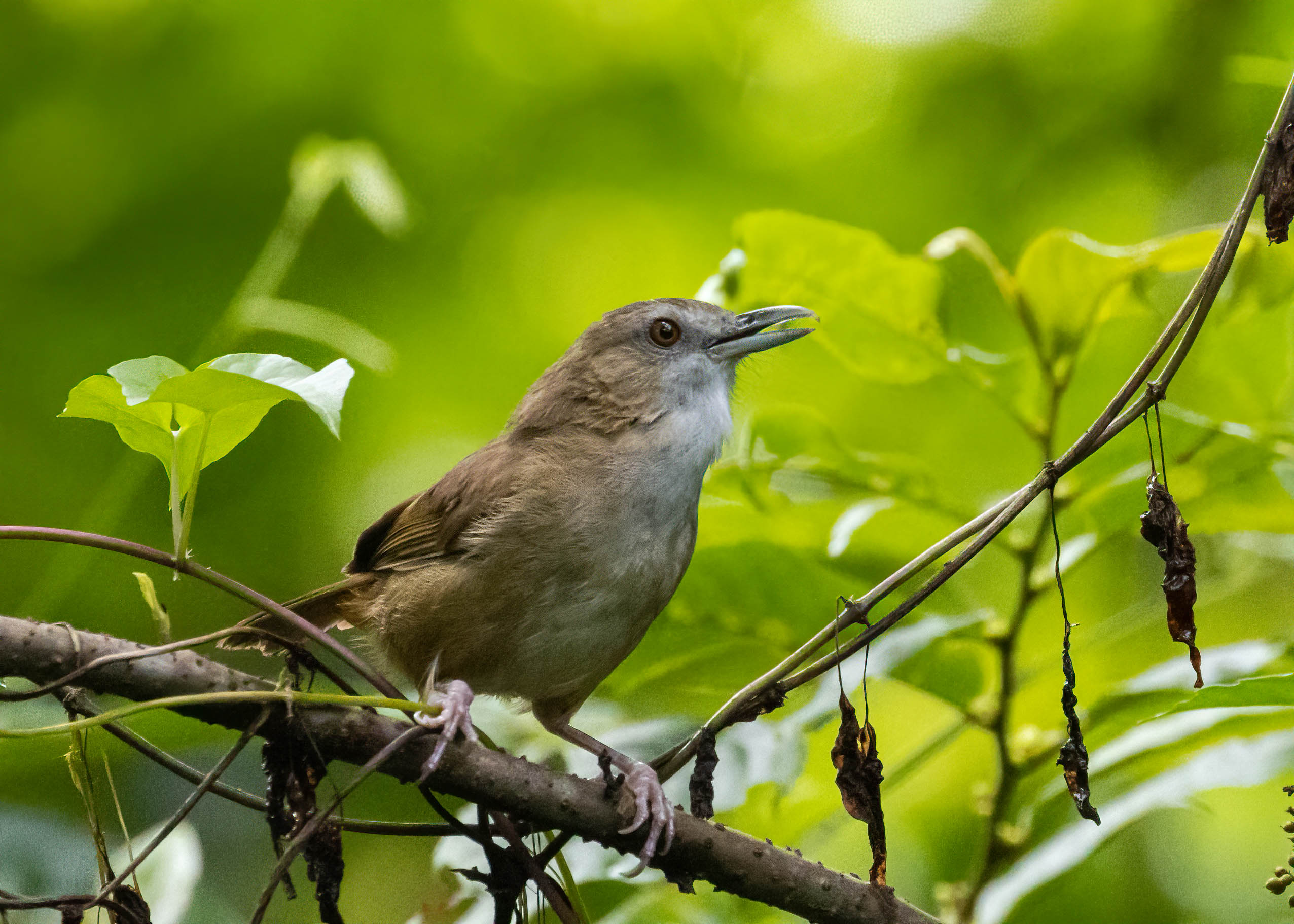
Scientific Name: Malacocincla abbotti
Conservation Status: Least Concern
Abbott’s Babbler is a widely distributed Babbler in south Asia and southeast Asia. It is a very noisy bird moving in low vegetation often near a stream.
-
Ashy Bulbul

Scientific Name: Hemixos flavala
Conservation Status: Least Concern
Ashy Bulbul is a sharply colored bird with bright yellow wings in the overall grey body. The neck is white. Its natural habitat is subtropical or tropical moist lowland forest and wooded foothills. This beautiful bulbul is normally seen in small flocks, sometimes with other bulbuls.
-
Asian Barred Owlet

Scientific Name: Glaucidium cuculoides
Conservation Status: Least Concern
This small owl is native to Indian subcontinent and some parts of southeast Asia. This nocturnal bird is often seen in the broad daylight as well. It perches openly on branches and on electric wires. It is dark brown in clolour having bars on the entire body. The habitat of Asian Barred Owlet is forest land and large gardens.
-
Asian Emerald Cuckoo

Scientific Name: Chrysococcyx maculatus
Conservation Status: Least Concern
Asian Emerald Cuckoo is a summer migrant to Assam. Its breeding range extends from the Himalayas eastwards to Myanmar, China and northern Thailand. Both the sexes of this brightly coloured small-sized cuckoo are different. It forages on the upper level of canopy where it feeds on caterpillars, ants and bugs.
-
Asian Emerald Dove

Scientific Name: Chalcophaps indica
Conservation Status: Least Concern
Asian Emerald Dove or Common Emerald Dove is a resident breeder of Indian subcontinent and southeast Asia. This beautiful bird is also known as Green-winged Pigeon or Grey-capped Emerald Dove. This bird is the state bird of the Indian state of Tamil Nadu. This is one of the widely distributed birds of Assam.
-
Asian Fairy Bluebird
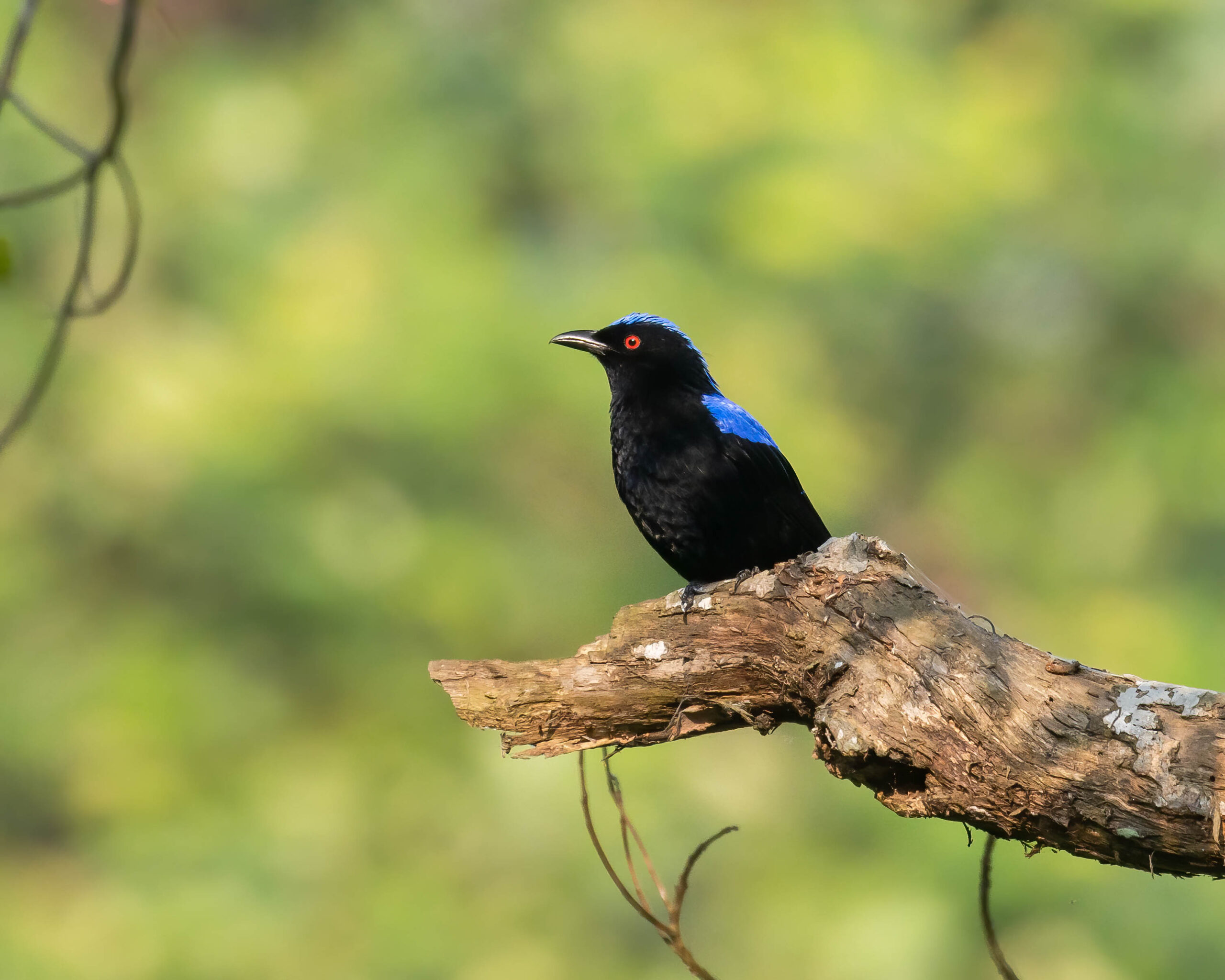
Scientific Name: Irena puella
Conservation Status: Least Concern
This beautiful blue bird is sexually dimorphic. The male is shining ultramarine-blue coloured with lilac reflections on the upper plumage while the female is brownish blue with the brighter edges of feathers. This bird feeds mainly on fruits.
-
Asian Koel

Scientific Name: Eudynamys scolopaceus
Conservation Status: Least Concern
Asian Koel is a well-known and popular bird in Assam. The male bird is glossy black with light green bill and the female is dark brown with white and buff spots. Though this bird is famous for its sweet call, it can be hardly spotted as it likes to hide on the treetop.
Asian Koel never makes a nest. It lays a single egg in the nest of other birds. After hatching, the chick is brought up by those birds along with their own brood. This phenomenon is called ‘brood parasitism’. Asian Koel is the State bird of the Indian State of Jharkhand.
-
Bar-headed Goose
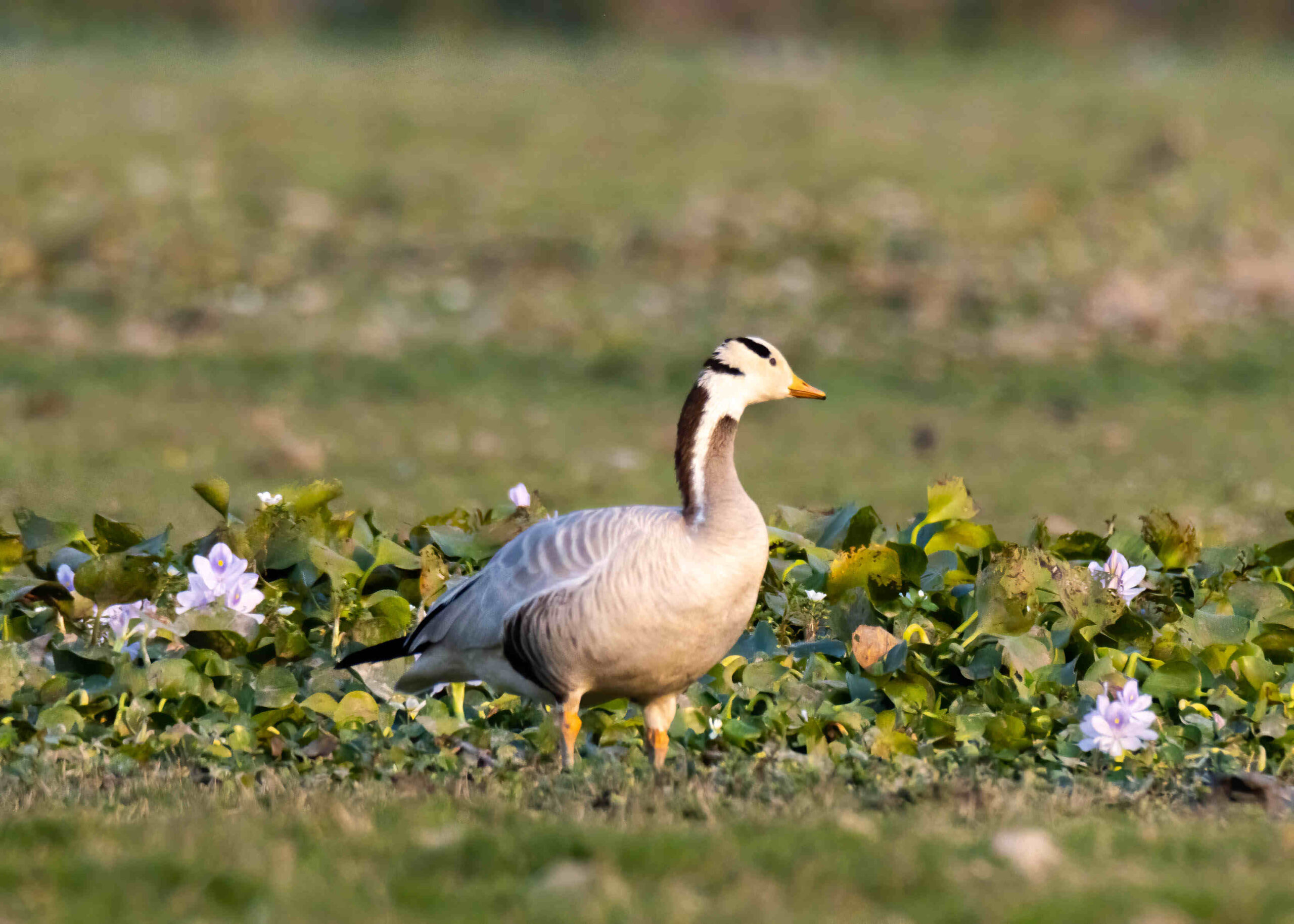
Scientific Name: Anser indicus
Conservation Status: Least Concern
This big-sized bird migrates to Assam during the winter season. With two black bars on the head, this bird can be easily identified. It breeds in Central Asia and migrates to Southeast Asia through Himalayas. Bar Headed Goose is one of the highest-flying birds in the world. There are records of this bird flying at an altitude at 7000 meters above sea level.
Flocks of Bar Headed Goose are seen in Assam at places like the Kaziranga National Park, Pobitora Wildlife Sanctuary, Subansiri floodplain etc. This bird is peace loving and never causes harm to other birds.
-
Barn Owl

Scientific Name: Tyto alba
Conservation Status: Least Concern
Barn Owl is one of the most widely distributed bird species in the world. It is found almost everywhere except the polar regions and the deserts. Like most owls, this is also a nocturnal bird; but sometimes seen in daylight as well. This owl is one of the most widely found birds of Assam.
-
Barn Swallow
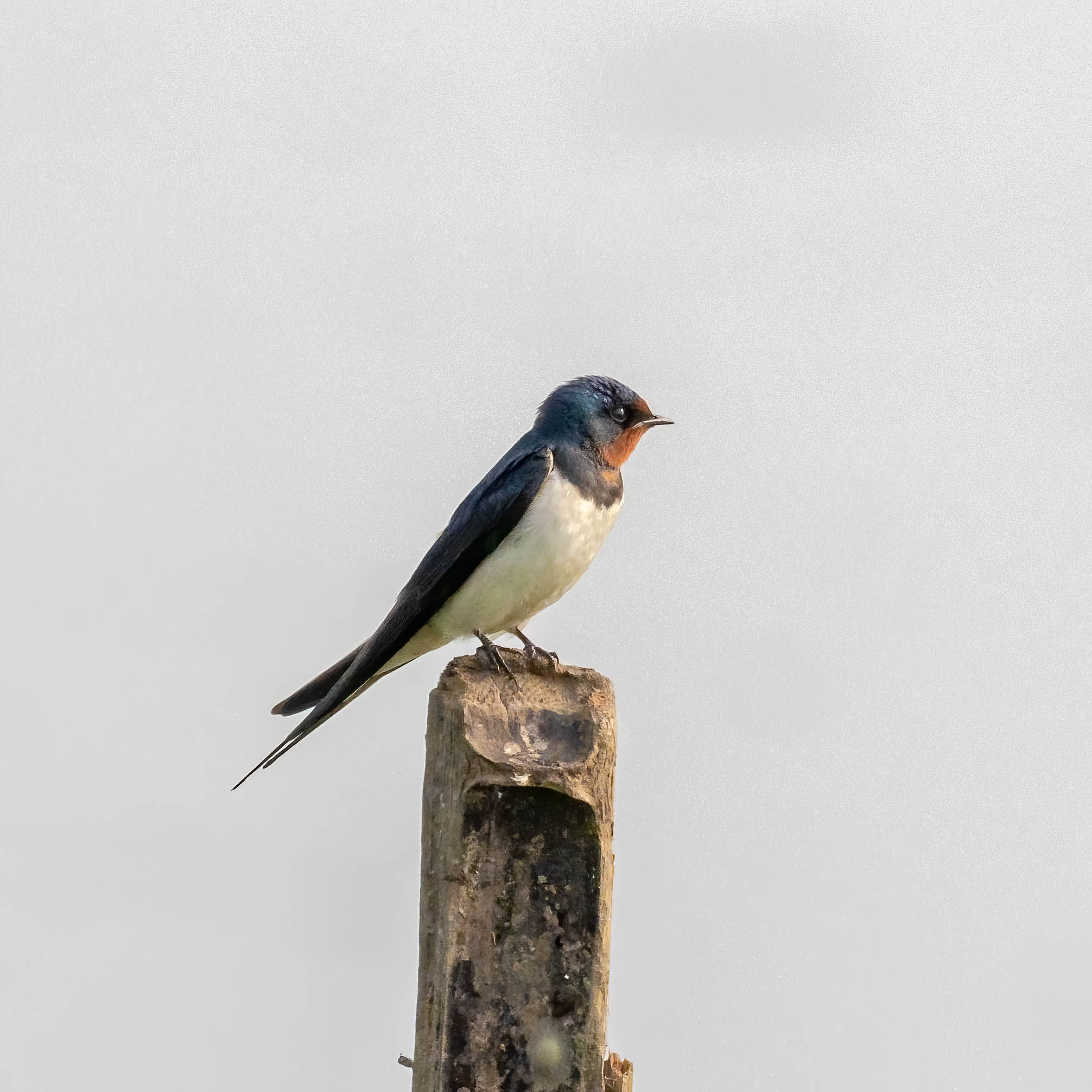
Scientific Name: Hirundo rustica
Conservation Status: Least Concern
Barn Swallow is the most widely distributed swallow in the world. Its ideal habitat is open land near water body. Barn swallows are seen perching on open branches and electric wires. This bird is one of the widely distributed birds of Assam.
-
Bay Woodpecker

Scientific Name: Blythipicus pyrrhotis
Conservation Status: Least Concern
This mid-sized woodpecker is a resident breeder of the Indian subcontinent. Their normal habitat is tropical or subtropical moist low land and subtropical or tropical moist montane forest. Though this species is listed as Least Concern by the International Union for Conservation of Nature (IUCN) in their Red List, sighting of this bird is not very much easy in comparison to the other woodpeckers.
-
Baya Weaver

Scientific Name: Ploceus philippinus
Conservation Status: Least Concern
This skilled weaver bird is resident to the Indian subcontinent and southeast Asia. Earlier this bird was very much common and omnipresent in the entire state of Assam. Nests of Baya Weaver in the beetle nut trees of the rural households of Assam was a common sighting a few years ago. But due to rapid urbanization and deforestation, the population of this bird has been declining in recent years.
-
Bengal Florican

Scientific Name: Houbaropsis bengalensis
Conservation Status: Critically Endangered
The Bengal Florican is one of the critically endangered birds of Assam. Less than 1000 individuals remain alive in the wild till 2017. A small population of this bird is in the Manas National Park, Assam. This bird is a Schedule I species as per the Wildlife (Protection) Act, 1972.
-
Black Drongo

Scientific Name: Dicrurus macrocercus
Conservation Status: Least Concern
Black Drongo is a resident breeder and widely spread throughout Assam. This bird is often seen on electric wire and open perch of a tree. It feeds on insects like grasshopper, cicada, wasps etc. This is a very fast flying bird and can catch insects in their flight. Black Drongo is one of the most common and widely distributed birds of Assam.
-
Black Kite
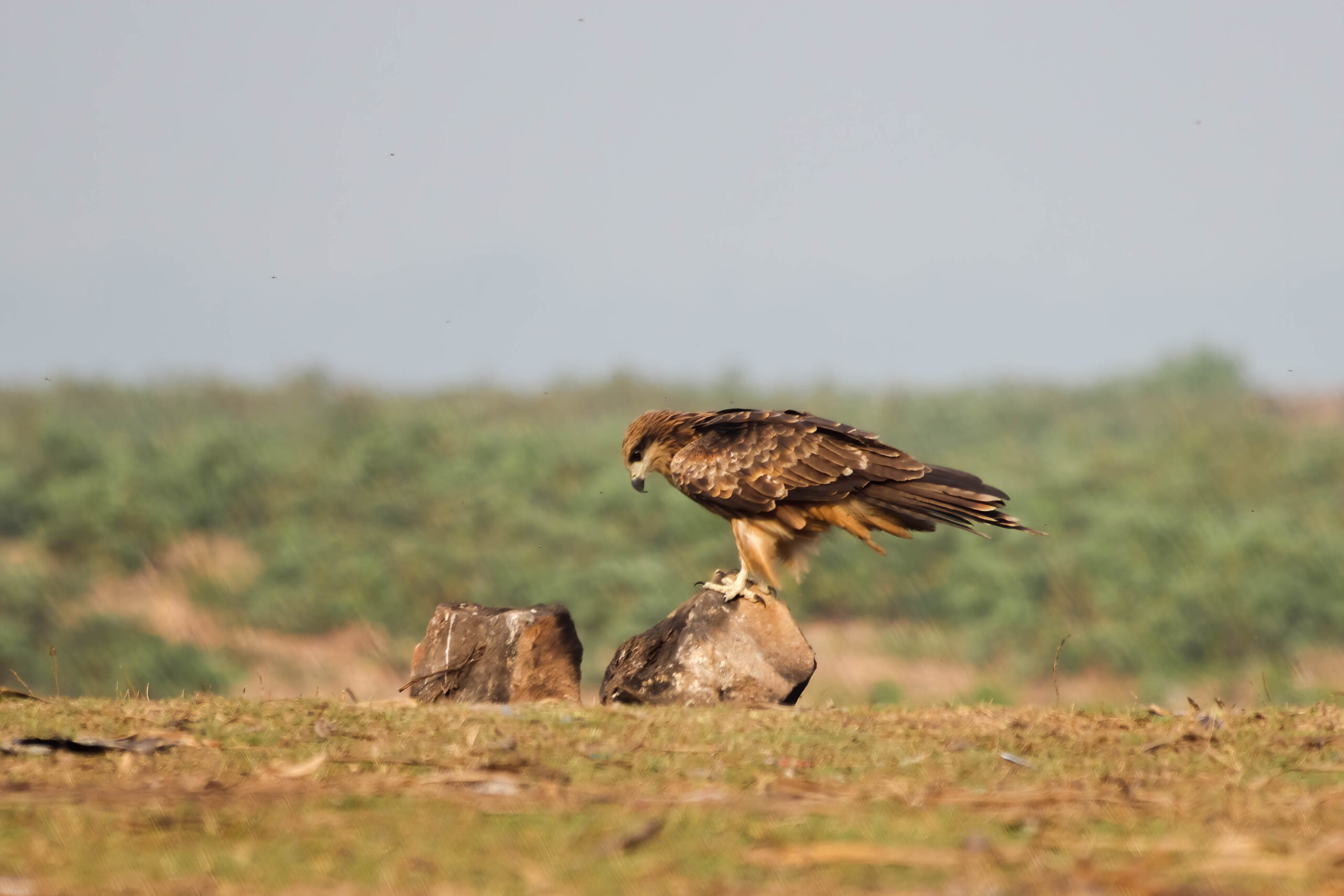
Scientific Name: Milvus migrans
Conservation Status: Least Concern
This is a carnivorous bird found in many places in the world including Europe, Asia, Africa and Australia. The estimated present global population of Black Kite is almost 6 million. It inhabits near human populated areas like cities, towns etc. Black Kite forages in the garbage dumps and wastages. This bird is often seen in conflict with House Crows and other birds.
-
Black-breasted Parrotbill

Scientific Name: Paradoxornis flavirostris
Conservation Status: Vulnerable
Black-breasted Parrotbill is an endemic bird to the Indian subcontinent. This small bird is found in the Manas National Park and Maguri grassland of Assam. Another disjunct population is in the state of Arunachal Pradesh. The IUCN has enlisted this bird under the category of Vulnerable species.
-
Black-breasted Weaver

Scientific Name: Ploceus benghalensis
Conservation Status: Least Concern
The male Black-breasted Weaver in breeding plumage has a yellow forehead and a black face. This bird is found in Assam at the places like Dorabeel, Pobitora Wildlife Sanctuary etc.
-
Black-crested Bulbul

Scientific Name: Rubigula flaviventris
Conservation Status: Least Concern
With a prominent black crest, this bird is an inhabitant of forests and dense scrub. Both the sexes are similar. But the juveniles are a little duller in color. It builds its nest in bushes and small trees. This is a very common bird in the lowland forests of Assam.
-
Black-headed Ibis

Scientific Name: Threskiornis melanocephalus
Conservation Status: Near Threatened
Black-headed Ibis is a waterbird of south and southeast Asia. It is the only native bird species in its range. In an overall white body, its head along with beak and legs are black. This is one of the common waterbirds of Assam. But due to habitat loss, the population of this bird has been declining in recent years.
-
Black-hooded Oriole

Scientific Name: Oriolus xanthornus
Conservation Status: Least Concern
This is one of the most common resident birds of Assam. The adult bird is yellow in colour with a black patch on the head and hood. The habitat of this bird mostly appears to be open agricultural lands and light forests. Black Hooded Oriole feeds on a variety of fruits and insects. This bird inhabits near human habitation as well.
-
Black-naped Monarch

Scientific Name: Hypothymis azurea
Conservation Status: Least Concern
Black-naped Monarch is a passerine bird. This bird is sexually dimorphic. The male has a distinctive black patch on the head in overall blue body while the female is duller with olive brown wings. The female bird does not have the black patch on the head. This inhabits in tropical forests of Assam.
-
Black-necked Stork

Scientific Name: Ephippiorhynchus asiaticus
Conservation Status: Near Threatened
This big-sized bird has a long neck and long legs. Both the sexes are monomorphic; but the colour of the iris of the female bird is yellow while the male having black iris. It feeds on fishes and other aquatic vertebrates and smaller water birds. Black Necked Stork forages in shallow water bodies. Assam is one of the major breeding areas of this resident bird.
Black Necked Stork is found in Assam at places like Kaziranga National Park, Pobitora Wildlife Sanctuary etc.
-
Black-winged Kite

Scientific Name: Elanus caeruleus
Conservation Status: Least Concern
This medium-sized kite is found in open savannah, semi desert and agricultural land with scattered woods in sub-Saharan Africa and tropical Asia. This bird of prey is known for its habit of hovering over open grasslands. The colour of this raptor is predominantly white or grey with black patches on the shoulder. This is one of the common raptors of Assam.
-
Blossom-headed Parakeet

Scientific name: Psittacula roseata
Conservation Status: Near Threatened
The Blossom-headed Parakeet is a resident parrot species of eastern Bangladesh, Bhutan, northeast India and Nepal. This bird nests in holes on tree trunks and lays 4-5 eggs in a regular cluster. This bird is found in Kaziranga National Park of Assam.
-
Blue Rock Thrush

Scientific Name: Monticola solitarius
Conservation Status: Least Concern
Blue rock thrush is an omnivorous bird feeds on a wide range of insects, small reptiles, berries and seeds. The breeding male has a striking blue-grey plumage, while the female has dark brown upper parts and paler brown scaly underparts. This is one of the common birds of Assam found across the entire state.
-
Blue-bearded Bee-eater
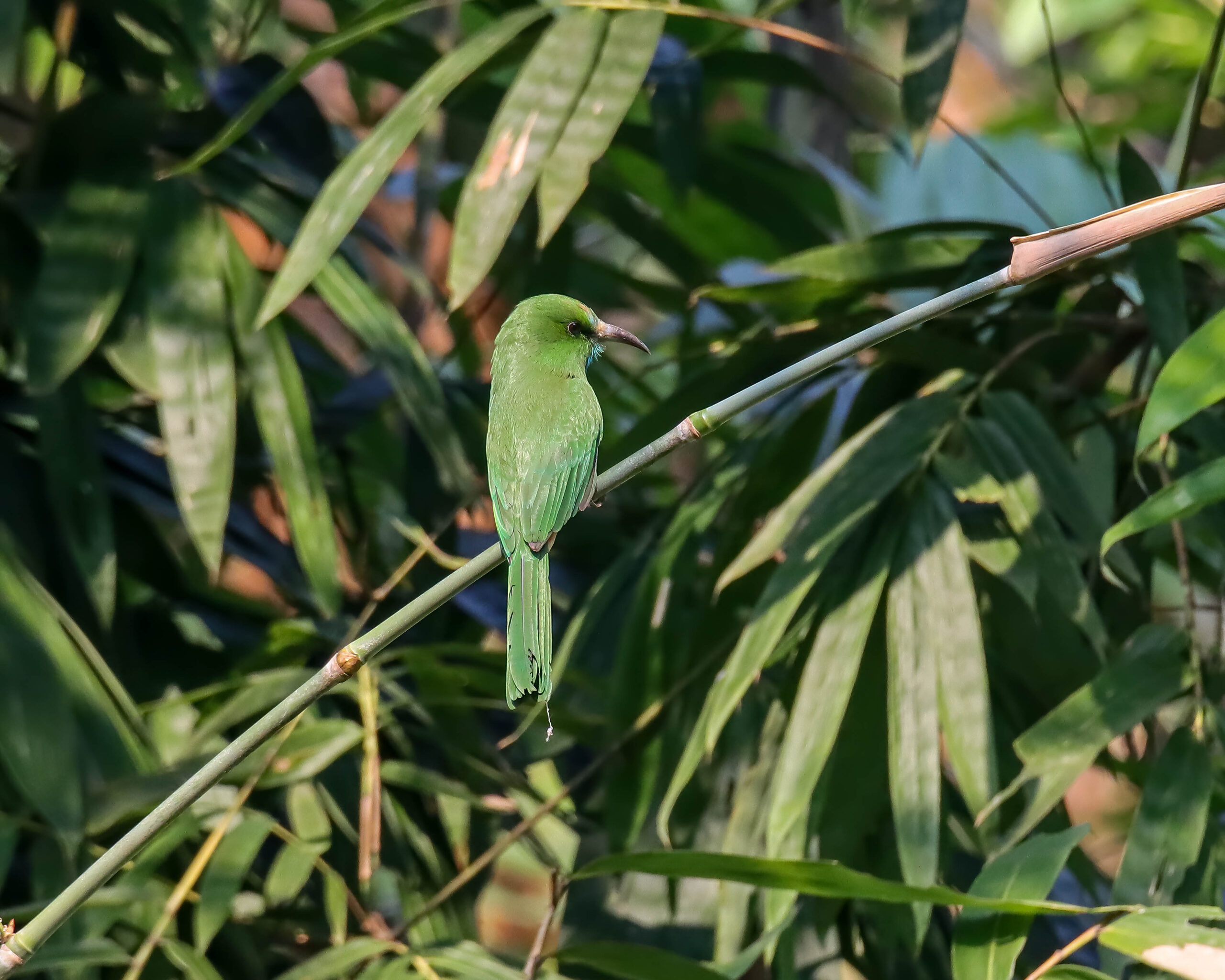
Scientific Name: Nyctyornis athertoni
Conservation Status: Least Concern
The Blue-bearded Bee-eater is the largest bird in the bee-eater family. Its elongated blue feathers on the neck justifies its nomenclature. This bird is a forest inhabitant. It has a loud call; but does not call frequently. It is not as much active as other bee-eaters. This bird is found in the forests of Assam.
-
Blue-napped Pitta

Scientific Name: Hydrornis nipalensis
Conservation Status: Least Concern
The Blue-naped Pitta is a resident breeder of Indian subcontinent. The tropical and subtropical moist lowlands are its normal habitats. This is a very elusive bird in nature. The name Blue-naped Pitta derives from the blue patch on the upper head of the bird. The high-pitched call of this bird can be heard easily from the dense undergrowth of Assam. But this bird seldom comes out in open.
-
Blue-throated Barbet

Scientific Name: Psilopogon asiaticus
Conservation Status: Least Concern
This colourful bird is native to the foothills of Himalayas and Southeast Asia. This resident breeder is predominantly bright green in colour with a blue patch on the neck and red on the head. This bird is widely found in all the forests and near human habitation throughout Assam. Loud and prominent calls of this bird could often be heard from the canopies. This is one of the most common and widespread birds of Assam.
-
Blue-throated Blue Flycatcher

Scientific Name: Cyornis rubeculoides
Conservation Status: Least Concern
This bird inhabits in dense forests of much of the Indian subcontinent. The male has a blue throat and an orange breast while the female has an olive head and upper parts with poorly defined creamy-orange chest and a white belly.
-
Blue-winged Leafbird

Scientific Name: Chloropsis moluccensis
Conservation Status: Least Concern
The Blue-winged Leafbird is found in the forests of Southeast Asia. The male is green bodied, black faced with a blue strip on the wings, while the female has a green head and a blue throat. This bird is found in almost all the forests of Assam.
-
Blue-winged Minla

Scientific Name: Actinodura cyanouroptera
Conservation Status: Least Concern
The Blue-winged Minla is also known as Blue-winged Siva. It is a resident breeder of Indian subcontinent and southeast Asia. Its natural habitat is tropical or subtropical moist montane forest.
-
Blyth’s Paradise Flycatcher

Scientific Name: Terpsiphone affinis
Conservation Status: Least Concern
Formerly, this bird was considered as a subspecies of Asian Paradise Flycatcher. But since 2015, it has been considered as a separate species. This is one of the most beautiful birds of Assam. This bird is found in places like Garbhanga Reserve Forest, Subansiri Reserve Forest, Jokai Reserve Forest, Manas National Park etc. in Assam.
-
Blyth’s Pipit

Scientific Name: Anthus godlewskii
Conservation Status: Least Concern
This insectivorous pipit species is very much similar to the Richard’s Pipit. But it is slightly smaller with shorter legs and shorter dark bill. This bird is found in open fields preferably near waterbody throughout Assam.
-
Bronzed Drongo

Scientific Name: Dicrurus aeneus
Conservation Status: Least Concern
The Bronzed drongo is a small bird belonging to drongo family. This is a resident bird of Indian subcontinent and southeast Asia. Bronzed drongo is known for its wide range of vocalization. This bird is particularly notable for its beautiful iridescent plumage, which shines in shades of blue, black, and bronze. This is one of the widespread birds in all the forests of Assam.
-
Brown Boobook

Scientific Name: Ninox scutulata
Conservation Status: Least Concern
Brown Boobook is also known as Brow Hawk Owl. This owl is a resident breeder in South Asia including India. This medium sized owl has a hawk like shape with its long tail. It is found in wide range of habitats including primary rainforests, orchards and gardens. Brown Boobook is also an inhabitant of human habitations. This is one of the common owls of Assam.
-
Cattle Egret

Scientific Name: Bubulcus ibis
Conservation Status: Least Concern
This is a widely distributed heron species in the world. Its entire body is white; but the breeding plumage is adorned with buff feathers. This bird is known for its rapid global expansion into new areas. The Cattle Egret removes ticks and flies from the body of the cattle and consumes it. This is one of the most common birds found in Assam.
-
Changeable Hawk Eagle

Scientific Name: Nisaetus cirrhatus
Conservation Status: Least Concern
The Changeable Hawk Eagle or Crested Hawk Eagle is a medium to large sized bird of prey found in the Indian subcontinent and southeast Asia. The name, Changeable Hawk Eagle is slightly misleading as there are two colour morphs available of this eagle; one is dark morph and the other is light morph. This expert predator feeds on different kinds of preys like small mammals, birds and snakes.
-
Chestnut Munia

Scientific Name: Lonchura atricapilla
Conservation Status: Least Concern
Chestnut Munia is a small bird usually seen in flocks. Both the sexes are similar. It feeds on grain and other seeds. Its ideal habitat is open grassland where it makes nest in bushes. This is a common bird of Assam.
-
Chestnut-bellied Nuthatch

Scientific Name: Sitta cinnamoventris
Conservation Status: Least Concern
The Chestnut-bellied Nuthatch is one of the two nuthatch species found in Assam. Its habitat is subtropical or tropical dry and moist forest. This bird is normally seen in flocks foraging on the tree trunks and branches.
-
Chestnut-headed Bee-eater

Scientific Name: Merops leschenaulti
Conservation Status: Least Concern
This brightly coloured bird is a resident breeder of the Indian subcontinent and some of its adjacent areas. The body color of the bird is green with a chestnut-coloured patch on the head. Its beak is black. It makes tunnel like nest in sand or slopes. As the name itself suggests, this bird feeds on bees, wasps, butterflies and hornets.
-
Chestnut-tailed Starling

Scientific Name: Sturnia malabarica
Conservation Status: Least Concern
This bird of Starling family is a resident breeder of Assam. Both the sexes are similar in appearance. However, the juveniles possess a white tail. This bird nests in the light forest and near human habitations. Like other starlings, the Chestnut-tailed Starling is also omnivorous and it feeds on a variety of fruits, nectar and insects. This is one of the very common birds of Assam.
-
Chestnut-winged Cuckoo

Scientific Name: Clamator coromandus
Conservation Status: Least Concern
The Chestnut-winged Cuckoo is a summer migrant to Assam. It breeds along the Himalayas including Assam and winters in southern Asia. This cuckoo species is usually seen singly; but sometimes it forages with mixed flocks. The natural habitat of this bird is lowland deciduous forest. This bird is found in the forests of Assam. This is one of the beautiful Cuckoos of Assam.
-
Cinerous Tit

Scientific Name: Parus cinereus
Conservation Status: Least Concern
This small bird is predominantly gray with white cheeks and black head. This bird is widely spread across Assam. It normally forages in pairs and is seldom seen in small flocks. Sometimes it forages with other birds as well. Cinereous Tit breeds in summer and lays eggs by making tunnel in the tree trunk. This is one of the most widespread and easily found birds of Assam.
-
Cinnamon Bittern

Scientific Name: Ixobrychus cinnamomeus
Conservation Status: Least Concern
This small bittern species breeds in India to Indo-China. It feeds on insects, fishes and amphibians. This bird is found near wetlands where it nests on reed beds. This is a common wetland bird of Assam.
-
Collared Falconet

Scientific Name: Microhierax caerulescens
Conservation Status: Least Concern
The Collared Falconet is a very small-sized bird of prey with an average length of 18 cm. It has short wings, medium-length tail, strong half-fathered legs and powerful feet. This bird is usually seen perched high up on exposed branches of open deciduous forests. This small raptor is found in the Manas National Park of Assam.
-
Collared Scops Owl

Scientific Name: Otus lettia
Conservation Status: Least Concern
This is a resident breeder in South Asia. This bird with varied plumage morphs and prominent ear tufts, is partially migratory. It is found in open wooded habitats from lowlands to foothills, often found roosting in temples, abandoned houses and gardens. It nests in tree trunk holes. This is one of the easily found owls of Assam.
-
Common Coot

Scientific Name: Fulica atra
Conservation Status: Least Concern
The Common Coot or Eurasian Coot is a member of rail and crake bird family. Its colour is black with a white bill and white frontal shield. It has partial webbing on its long and strong toes which helps it swimming. Both the sexes of this bird are similar.
-
Common Green Magpie

Scientific Name: Cissa chinensis
Conservation Status: Least Concern
This loud and brightly coloured bird is found in the evergreen forests of lower Himalayas. It forages both on the ground and on the trees. It feeds a wide range of invertebrates, small reptiles and small mammals. This is one of the common forest living birds of Assam.
-
Common Greenshank

Scientific Name: Tringa nebularia
Conservation Status: Least Concern
The Common Greenshank is a wader which migrates to the Indian subcontinent including Assam during winter season. It has a long greenish leg and a long bill with a grey base. Like most waders, it feeds on small invertebrates, small fishes and amphibians. This bird is found near the freshwater wetlands and rivers of Assam.
-
Common Kingfisher

Scientific Name: Alcedo atthis
Conservation Status: Least Concern
This is a resident breeder of Europe, Asia and North Africa. That is why another name of this species is Eurasian Kingfisher. It mainly feeds on small fishes. This bird is found near all types of wetlands of Assam. This sparrow-sized bird is one of the most common and widespread kingfishers of Assam.
-
Common Moorhen

Scientific Name: Gallinula chloropus
Conservation Status: Least Concern
The Common Moorhen is one of the most widely distributed rail species in the world. The habitats of this bird are well vegetated marshes, ponds, canals and other wetlands. It feeds on wide varieties of vegetable materials and small aquatic creatures. This is a widely distributed rail species found in Assam.
-
Common Snipe

Scientific Name: Gallinago gallinago
Conservation Status: Least Concern
The Common Snipe is a small-sized wader. This is a well camouflaged bird with an elongated bill. It forages on soft muds and feeds of insects and earthworms. This bird is found in the wetlands of Assam.
-
Common Tailorbird
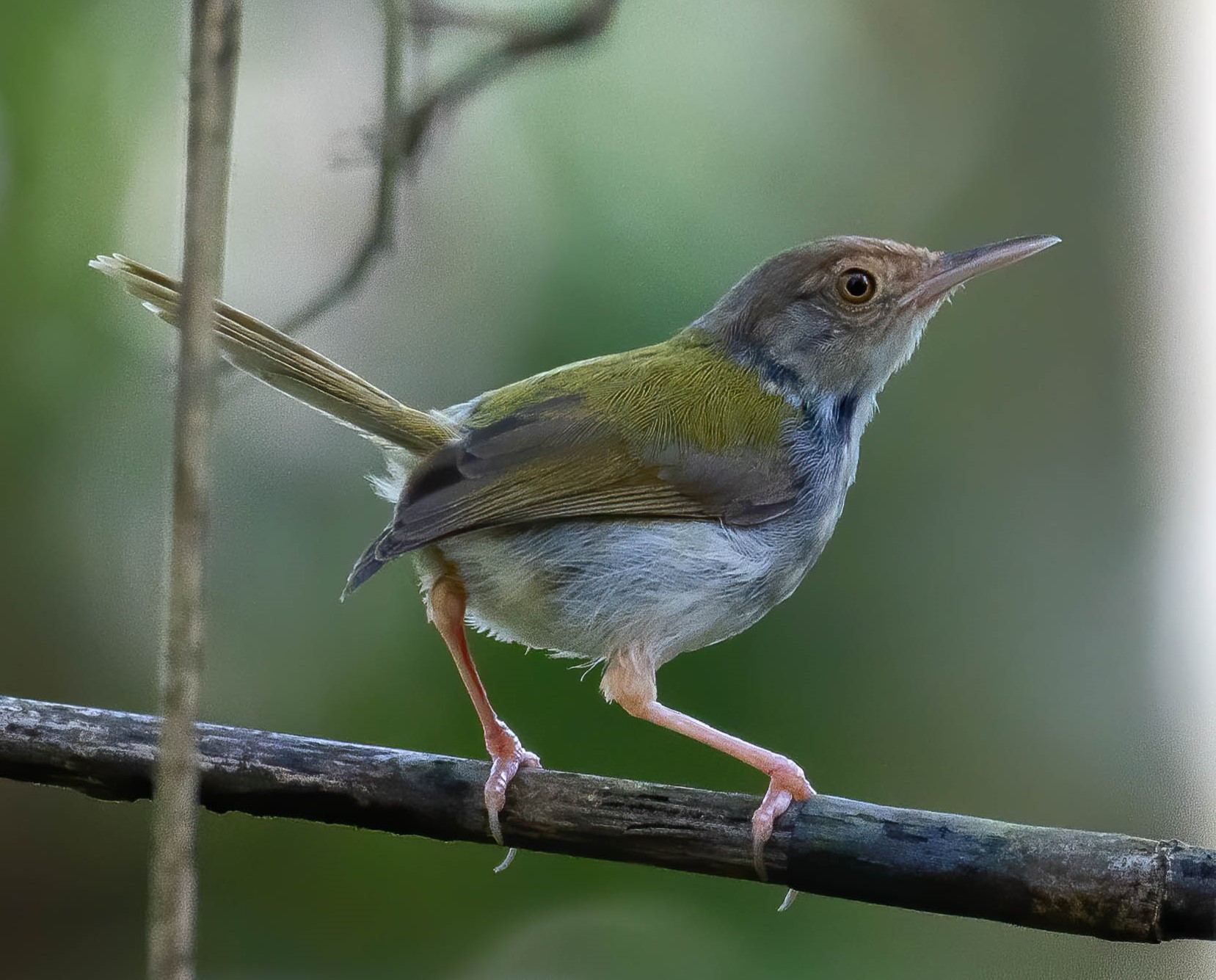
Scientific Name: Orthotomus sutorius
Conservation Status: Least Concern
This small songbird is a resident breeder of tropical Asia and widely distributed in the entire state of Assam. It inhabits in forests and near human habitations. This bird is popular for its nest which it makes impeccably by stitching leaves of trees. Common Tailorbird feeds on small insects. This is one of the most common birds of Assam.
-
Common-hawk Cuckoo

Scientific Name: Hierococcyx varius
Conservation Status: Least Concern
The Common Hawk Cuckoo is a resident bird of the Indian subcontinent. Its appearance is similar to a Shikra. Therefore, the name of this group of cuckoos are named as Hawk cuckoo. This bird is a brood parasite and lays eggs in the nests of Babblers. The Common Hawk Cuckoo is one of the most common birds of Assam.
-
Crested Serpent Eagle

Scientific Name: Spilornis cheela
Conservation Status: Least Concern
This is a medium-sized eagle. It feeds on snakes, lizards, small birds and fishes. The color of face and legs of this bird are yellow with white and yellow dotted underpart. In some places of India, it becomes active only in summer. This bird makes nest near river and breeds in the early summer. Crested Serpent Eagle is a widely distributed raptor of Assam.
-
Crimson Sunbird

Scientific Name: Aethopyga siparaja
Conservation Status: Least Concern
Crimson Sunbird is a resident breeder of the tropical Asia including India. This bird mainly feeds on nectar. But it also consumes small insect. This bird is widely distributed throughout Assam.
-
Dark-necked Tailorbird

Scientific Name: Orthotomus atrogularis
Conservation Status: Least Concern
This is a brightly coloured tailorbird with a black patch on the neck. It’s natural habitat is lowland tropical forest. This bird is almost similar to the Common tailorbird. The only differences are its extended rufous crown and more district dark patch on the neck. This bird is found in the forests of Assam.
-
Daurian Redstart

Scientific Name: Phoenicurus auroreus
Conservation Status: Least Concern
The Daurian Redstart is one of the winter migratory birds of Assam. This bird is distinctly sexual dimorphic. The male is brighter in colour and the female has pale colours. It prefers open forests, forest edges, agricultural margins and parks as its habitat.
-
Dusky Eagle Owl

Scientific Name: Ketupa coromandus
Conservation Status: Least Concern
A widely distributed owl in South and Southeast Asia. This big-sized owl is greyish brown in colour and its ears are long and prominent. This nocturnal bird has visibility in broad daylight as well. It becomes active in cloudy weather during day time and after sunset. Dusky Eagle Owl breeds in winter.
-
Dusky Warbler

Scientific Name: Phylloscopus fuscatus
Conservation Status: Least Concern
This leaf warbler is a winter migrant to south and southeast Asia including Assam. Like most warblers, this is also sexually identical. This is an insectivorous bird. This warbler is one of the most commonly found birds of Assam during winter season.
-
Eastern Marsh Harrier

Scientific Name: Circus spilonotus
Conservation Status: Least Concern
The Eastern Marsh Harrier is a winter migratory bird to the northeastern part of India. Like many other birds of prey, the female Eastern Marsh Harrier is a little larger in size than the male. The plumage of the male bird is variable and the female is of dark brown colour with buff streaking on the head and underparts. This bird is found in the Pobitora Wildlife Sanctuary, Assam.
-
Eurasian Wigeon

Scientific Name: Mareca penelope
Conservation Status: Least Concern
The Eurasian Wigeon is a winter migrant to Assam. This dabbling duck is a bird of open wetlands. It feeds on aquatic plants by dabbling into the water. This is a commonly found duck in the wetlands of Assam during winter season.
-
Fulvous-breasted Woodpecker

Scientific Name: Dendrocopos macei
Conservation Status: Least Concern
This beautiful medium-sized bird is a resident breeder of Indian subcontinent. The male has a red crown with orange forehead while the female has a black crown. Both the sexes have prominently stripped wings. This is one of the most common woodpeckers of Assam.
-
Grey Wagtail

Scientific Name: Motacilla cinerea
Conservation Status: Least Concern
This member of wagtail family winters in Africa and Asia including Assam. It prefers habitats near water body especially a running stream. Like other wagtails, this bird also wags its tail frequently and flies low with a sharp call.
-
Grey-backed Shrike

Scientific Name: Lanius tephronotus
Conservation Status: Least Concern
The Grey-backed Shrike is a widespread shrike species of Assam. It feeds on insects like moths, crickets, grasshoppers, beetles and small vertebrates such as lizards, frogs etc. as usual diet. This is one of the most widely distributed birds of Assam during winter season.
-
Grey-bellied Tesia

Scientific Name: Tesia cyaniventer
Conservation Status: Least Concern
The Grey-bellied Tesia is a tiny bird with comparatively long legs and a short tail. This is a super skulker, who moves rapidly through dark and dense undergrowth. This bird is found in Assam during winter season only.
-
Grey-headed Canary Flycatcher

Scientific Name: Culicicapa ceylonensis
Conservation Status: Least Concern
This small flycatcher is a resident bird of tropical Asia. It is found in forested areas sometimes foraging with mixed flocks. With a grey hood and yellow underpart, this bird is insectivorous. During the winter season, this is one of the easily found birds of Assam.
-
Grey-headed Fish Eagle

Scientific Name: Haliaeetus ichthyaetus
Conservation Status: Near Threatened
This large eagle having dark brown back and grey head is a resident breeder in India and Southeast Asia. As the name suggests, its primary food is fish. But sometimes it feeds on small reptiles as well. Grey-headed Fish Eagle is found in the places like Kaziranga National Park, Manas National Park etc. in Assam.
-
Grey-headed Swamphen

Scientific Name: Porphyrio poliocephalus
Conservation Status:
This bird is bright blue with a red beak. This is a widely distributed bird in the lakes, ponds, other water bodies and cultivated lands of Assam. Though it forages normally in pair, but sometimes seen in small flocks. It feeds on the seeds of varieties of aquatic plants and small aquatic insects. Grey Headed Swamphen breeds in rainy season. This beautiful bird has a loud and cackling call.
-
Grey-headed Woodpecker

Scientific Name: Picus canus
Conservation Status: Least Concern
This medium sized woodpecker prefers deciduous forest for living. Due to its wide distribution around the world, the IUCN enlists this species as Least Concern in their Red list. But unfortunately, the population of Grey-headed woodpecker has been declining in recent years.
-
Greylag Goose

Scientific Name: Anser anser
Conservation Status: Least Concern
This is a large wader bird with an average weight of 3.3 kgs. This goose is known to be the ancestor of most of the domesticated goose species. This bird migrates to Assam in the winter season. They inhabit near lake and other large water bodies and feed on varieties of aquatic plants. Graylag Goose are normally monogamous; that is, they spend their lifetime with only one mating partner.
Big flocks of this bird are seen in the large waterbodies of Assam during the winter season.
-
Grey-winged Blackbird

Scientific Name: Turdus boulboul
Conservation Status: Least Concern
The name of this bird describes its basic appearance. The male bird is black and the female is brown; but both the male and the female have silvery-grey wings. This bird of thrush family forages quietly in the evergreen forests.
-
Great Cormorant

Scientific Name: Phalacrocorax carbo
Conservation Status: Least Concern
This bird feeds on fish and being an expert fishing bird, earlier it was targeted by the fishermen community. However, now killing of wild fauna and flora has been banned under legislative enactments. The entire body of this bird is black except the white patches in the neck and chest. This is one of the widespread birds of Assam in the wetlands.
-
Great Egret

Scientific Name: Ardea alba
Conservation Status: Least Concern
The Great Egret is a large and widely distributed egret species around the world. The body colour of this bird is white. This is a common and widespread bird of Assam. Great Egret feeds on fishes and other aquatic invertebrates.
-
Great Hornbill

Scientific Name: Buceros bicornis
Conservation Status: Vulnerable
This is the State bird of Arunachal Pradesh, an Indian state. This large bird with the massive yellow beak can easily be identified. This bird is found in the Indian subcontinent and Southeast Asia. The flapping of its wings while in flight makes a loud noise. It inhabits in dense forests or rainforests. Great Hornbill feeds on varieties of fruits and lizards. Similar as the ‘Oriental Pied Hornbill’s this bird is also a good pollinator and helps in natural plantation. This bird is found in the forests of Assam.
-
Great Slaty Woodpecker

Scientific Name: Mulleripicus pulverulentus
Conservation Status: Vulnerable
This is the largest known species of woodpecker. This woodpecker prefers primary forests as its natural habitat. This unique looking woodpecker is a resident breeder of Indian subcontinent. The global population of this bird is declining because of habitat loss. Therefore, as per the IUCN Red list, this woodpecker is a Vulnerable species. This is one of the rarest woodpeckers of Assam.
-
Great-crested Grebe

Scientific Name: Podiceps cristatus
Conservation Status: Least Concern
This is the largest member of grebe family. The Great-crested Grebe breeds in freshwater lakes. This bird has an elaborate courtship display. This bird is found in the rivers and large waterbodies of Assam.
-
Greater Adjutant

Scientific Name: Leptoptilos dubius
Conservation Status: Endangered (population decreasing)
This is a large bird with a massive bill and a pouch in the neck. This bird is a scavenger and the Assamese name of the bird suggests its food habit. (‘Hargila’ in Assamese means ‘bone shallower’). Earlier this was a widely distributed bird in South and Southeast Asia. But unfortunately, its population has been decreasing rapidly and its breeding areas have also become confined. Presently there are only three breeding areas of Greater Adjutant around the world, Assam being the largest one.
At present the estimated global population of this wader is less than 2000 birds. Pollution of wetlands is one of the major causes of rapid declination of population of this bird. Deepor Beel of Guwahati, Assam; a ‘Ramsar site’ is one of the largest habitats of Greater Adjutant.
-
Greater Coucal

Scientific Name: Centropus sinensis
Conservation Status: Least Concern
This bird is a resident breeder of Indian subcontinent and Southeast Asia. The wings of this crow sized bird are coppery brown and the head and tail is black. Greater Coucal is a low flying bird and a habitant of forest and cultivated land. It feeds on insects, caterpillars, snails etc. This bird breeds in the summer. This is one of the common birds of Assam.
-
Greater Flame-back Woodpecker

Scientific Name: Chrysocolaptes guttacristatus
Conservation Status: Least Concern
Greater flame-back woodpecker is also known as Greater golden-back. The male of this large woodpecker has a red crown while the crown colour of the female differs depending upon the subspecies. Like other woodpeckers, the Greater flame back also uses its beak to dig out foods from tree trunk.
-
Greater Necklaced Laughingthrush

Scientific Name: Pterorhinus pectoralis
Conservation Status: Least Concern
This is a large and long tailed bird of subtropical or tropical moist forest. Greater necklaced laughingthrush is a very shy bird usually forages in flocks in the dense forest.
-
Greater Yellownape Woodpecker

Scientific Name: Chrysophlegma flavinucha
Conservation Status: Least Concern
This large, olive-green woodpecker has a prominent yellow nape. This bird is a resident breeder of Asia. Dense broad leaf forest is the natural habitat of the Greater yellownape woodpecker.
-
Green Bee-eater or Asian Green Bee-eater

Scientific Name: Merops orientalis
Conservation Status: Least Concern
The Green Bee-eater or Asian Green Bee-eater is one of the most widely distributed birds of Assam. This bird is an inhabitant of open grassland and thin scrub. The Green bee-eater is an insectivorous bird and feeds on various insects, grasshoppers and caterpillars. This bird is found everywhere in Assam.
-
Green-billed Malkoha

Scientific Name: Phaenicophaeus tristis
Conservation Status: Least Concern
This is a resident breeder of Indian subcontinent and southeast Asia. With a green bill and a long tail, this large and shy bird is found in the forests of Assam.
-
Hair-crested Drongo
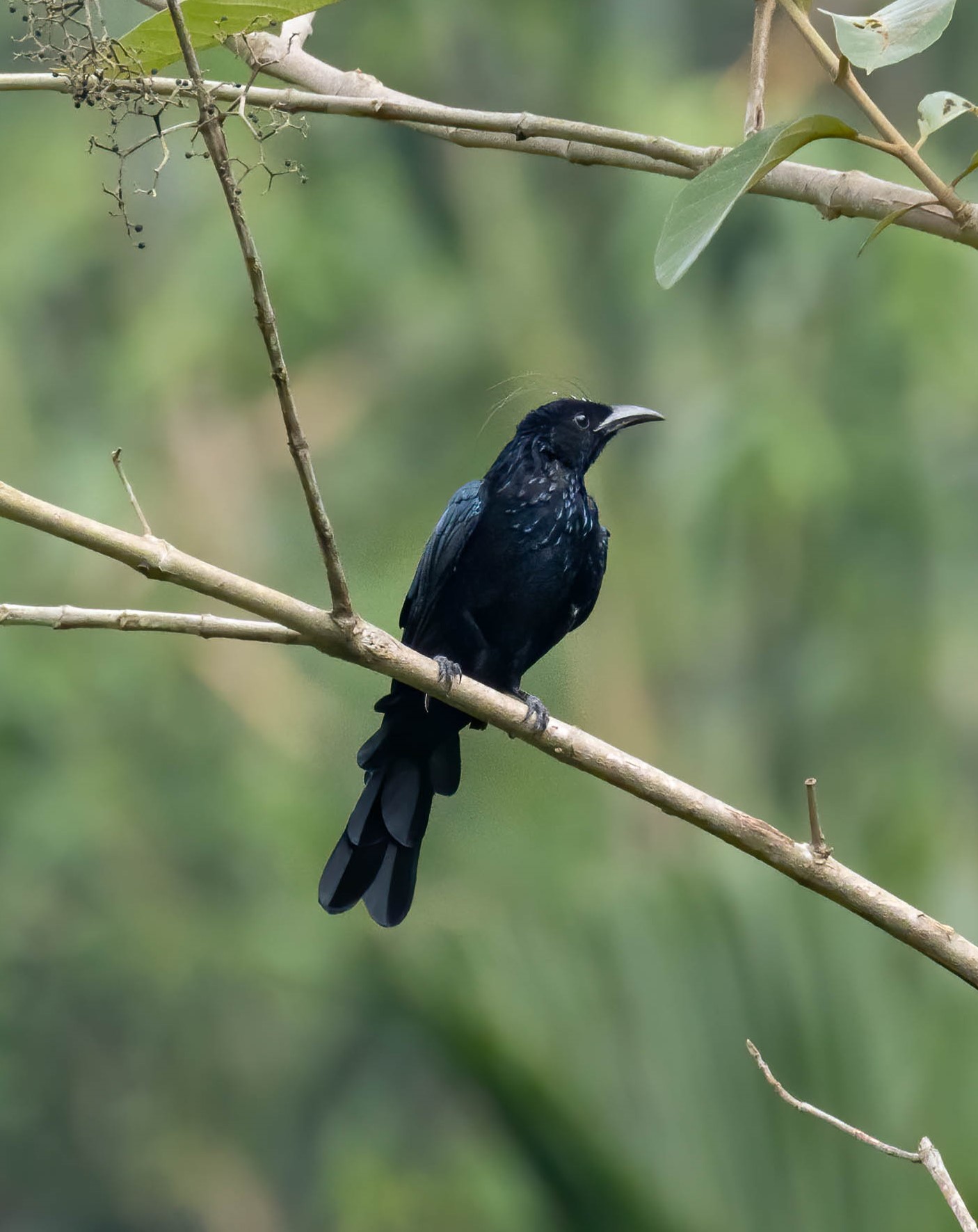
Scientific Name: Dicrurus hottentottus
Conservation Status: Least Concern
This is a big, stocky and dark drongo with highly iridescent wings and shiny feather. This species is native to India, Bangladesh, Bhutan through Indochina to China, Indonesia and Brunei. The Hair-crested drongo is known for their wide range of vocalizations, and aerial acrobatics. This is one of the widely distributed drongos of Assam.
-
Hooded Pitta

Scientific Name: Pitta sordida
Conservation Status: Least Concern
This beautiful bird is predominantly green with blue wings and black head. It inhabits in dense jungles and bamboo forests. It forages on the ground and feeds on insects and fruits. It prefers damp and wet areas to live. This bird is found in the dense and wet forests of Assam. Hooded Pitta is a summer migrant to Assam.
-
Hoopoe

Scientific Name: Upupa epops
Conservation Status: Least Concern
Hoopoe or Eurasian Hoopoe is a resident breeder in Africa, Asia and Europe. This bird can adapt himself at diversified habitats like grassland, forest, cultivated land etc. Therefore, the presence of this bird is notable in these three continents in the world. This bird eats the insects of the cultivated land and hence it is a friend of farmers. This bird is one of the most widely distributed birds of Assam.
-
Ibisbill

Scientific Name: Ibidorhyncha struthersii
Conservation Status: Least Concern
This bird is found in Central Asia and throughout the Himalayas. It has a down curved long red bill and red legs in a grey body with white underparts. This is a waterbird. Ibisbill is found in the Jia Bharali river of Assam.
-
Indian Peafowl
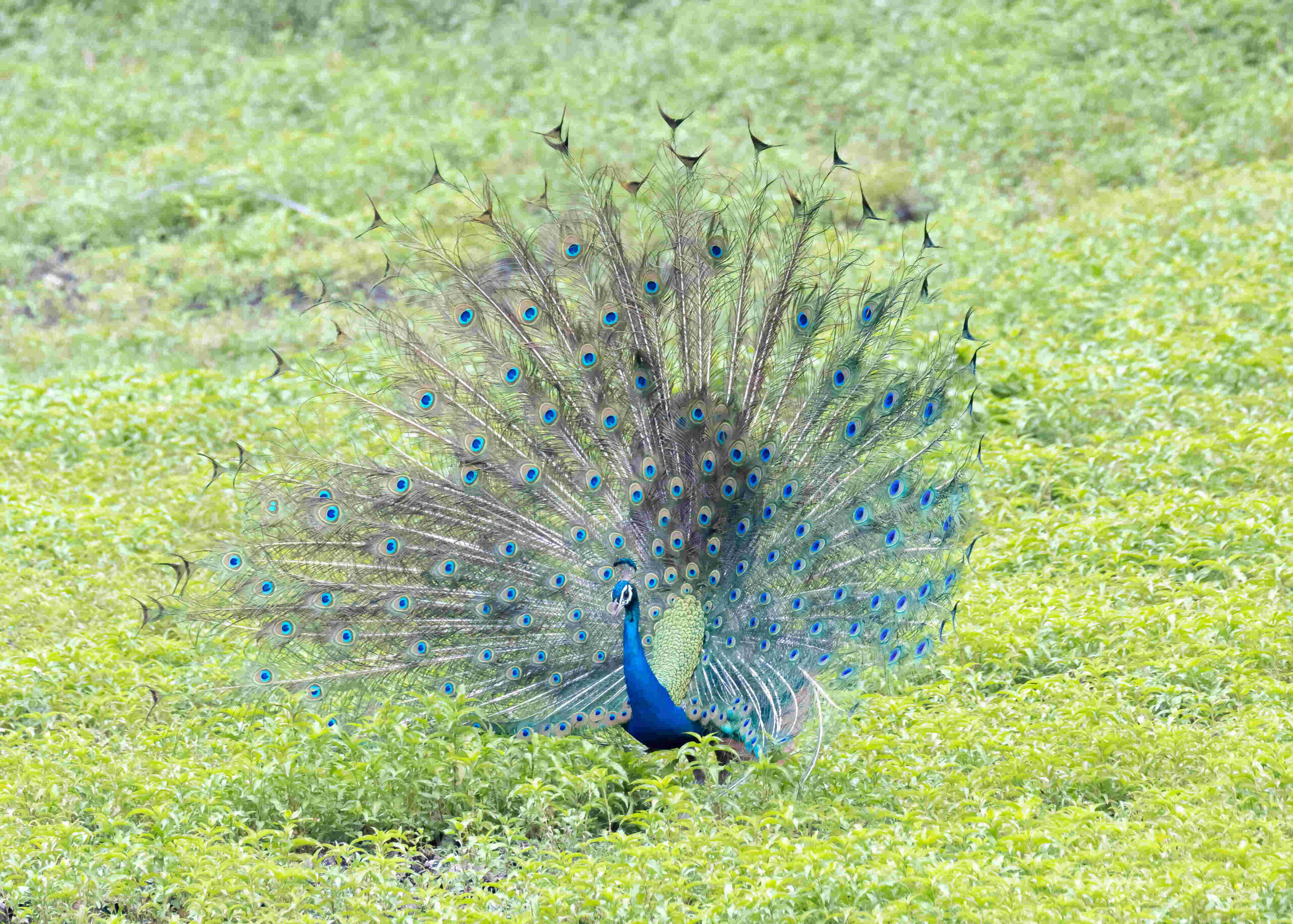
Scientific Name: Pavo cristatus
Conservation Status: Least Concern
The Indian Peafowl is the National bird of India. This bird is a resident breeder in the Indian subcontinent. This large bird with a long neck is sexually dimorphic. The male is bright blue and the female is brown. The male Indian Peafowl displays its feathers of elongated tail to attract the female bird. This bird is carnivorous and eats fruits, lizards, snakes, insects etc. Manas National Park, Assam and its buffer areas are home to a lot of Indian Peafowl.
-
Indian Pond Heron

Scientific Name: Ardeola grayii
Conservation Status: Least Concern
This is a small-sized heron with a typical long neck like other herons. This bird is widely distributed in the wetlands of Assam. Indian Pond Heron feeds on fishes, frogs and other aquatic invertebrates. This bird looks like an ‘Egret’ in flight as the white underparts are exposed prominently during flight. This is one of the most widespread and easily found birds of Assam.
-
Indian Spot-billed Duck

Scientific Name: Anas poecilorhyncha
Conservation Status: Least Concern
Indian spot-billed duck is a non-migratory dabbling duck. It breeds in the freshwater lakes throughout India. Its name derives from the prominent red spot at the base of the bill. One of the major habitats of this bird in Assam is the Kaziranga National Park.
-
Indian Thick knee

Scientific Name: Burhinus indicus
Conservation Status: Least Concern
This bird is also known as Indian stone-curlew. This brown colored ground bird with large eyes often camouflages itself against rocky and sandy surface. It feeds on insects, worms and small reptiles.
-
Indian White Eye

Scientific Name: Zosterops palpebrosus
Conservation Status: Least Concern
This pocket-sized bird is one of the most widely distributed birds of Assam. It forages in flocks and feeds on small insects and nectar. The Indian white eye can be easily identified by the white ring in its eyes. This bird is found in open woodlands and near human habitations as well.
-
Indo-Chinese Roller

Scientific Name: Coracias affinis
Conservation Status: Least Concern
This bird is found in eastern India to Myanmar and southeast Asia. It feeds on insects and lizards. The call of this colourful bird is very loud and rough. This is one of the most widespread birds of Assam.
-
Jerdon’s Baza

Scientific Name: Aviceda jerdoni
Conservation Status: Least Concern
This is a medium-sized bird of prey found in southeast Asia. The Jerdon’s Baza is looked like a Crested Goshawk or Changeable Hawk Eagle in flight. The prominent white tipped black crest, which is usually held erected, is the unmistakable identifier of this raptor of Assam.
-
Jungle Babbler

Scientific Name: Argya striata
Conservation Status: Least Concern
This bird forages in small flock numbering from 6 – 10 in a flock. Well, this number goes as ‘seven’ in the Assamese oral history, and the flocks of this bird have been named as ‘Saat Bhani’ (Seven sisters). This is a common resident bird in the Indian subcontinent. Jungle Babbler feeds on insects and fruits. This is one of the most common and widespread birds of Assam.
-
Kalij Pheasant

Scientific Name: Lophura leucomelanos
Conservation Status: Least Concern
This pheasant is found in the forests of Himalayan foothills. Both the sexes are different in plumage. The male is glossy bluish black while the female is overall brown. Like other pheasants, this is also a very shy bird found in the dense forests of Assam.
-
Large Woodshrike

Scientific Name: Tephrodornis virgatus
Conservation Status: Least Concern
This is a resident bird of southeastern Asia. Its natural habitats are temperate forests, subtropical or tropical lowland forests. This is an insectivorous bird.
-
Large-tailed Nightjar

Scientific Name: Caprimulgus macrurus
Conservation Status: Least Concern
This nocturnal bird is a resident breeder of Indian subcontinent. It is found along the southern Himalayan foothills. The metallic call of this bird is heard from a long distance at night. This bird is found in the forests of Assam. This is one of the nocturnal birds of Assam.
-
Lesser Adjutant

Scientific Name: Leptoptilos javanicus
Conservation Status: Vulnerable
This widely distributed bird in India and Southeast Asia resides in wetlands and cultivated lands. This bird is almost similar to the Greater Adjutant; but it is a bit smaller in size and it lacks the pouch. Its neck and head are naked with scattered hair-like feathers. The Lesser Adjutant is found in Assam, West Bengal and Bihar in India. This bird feeds on fish, frog, reptiles and other invertebrates and forage in shallow water. This is a widely distributed bird in the wetlands of Assam.
-
Lesser Shortwing

Scientific Name: Brachypteryx leucophris
Conservation Status: Least Concern
This tiny bird is a super skulker and loves to hide in the dense undergrowth of subtropical or tropical moist montane forests. The Lesser shortwing is a winter migrant to Assam. The call of this bird can easily be heard in the dense forests of Assam during winter. But it is very much difficult to spot the bird in its habitat.
-
Lesser Yellownape Woodpecker

Scientific Name: Picus chlorolophus
Conservation Status: Least Concern
Lesser yellownape is a widely distributed woodpecker in the tropical and subtropical Asia. There are some dissimilarities in colour of both the sexes. The juveniles are similar to the females in colour, but a little duller. This woodpecker species is found in the forests across the state of Assam.
-
Lineated Barbet

Scientific Name: Psilopogon lineatus
Conservation Status: Least Concern
Lineated barbet is one of the most widely distributed and easily found birds of Assam. This bird is found in all types of habitats including forests and human habitations even cities and towns. The loud and continuous call of this bird can easily be heard in all types of forests of Assam. This bird feeds on fruits and insects.
-
Little Bunting

Scientific Name: Emberiza pusilla
Conservation Status: Least Concern
This is a small passerine bird. The Little bunting is a winter migratory bird to Assam. Both the sexes are similar.
-
Little Cormorant

Scientific Name: Microcarbo niger
Conservation Status: Least Concern
This is a common and well-known bird in Assam. This bird is seen in the ponds, lakes, rivers and other water bodies. It feeds on fishes, frogs and other aquatic invertebrates. The breeding plumage of the Little Cormorant is entirely black and non-breeding plumage is slightly dark brown. This is one of the most widely distributed birds of Assam.
-
Little Egret

Scientific Name: Egretta garzetta
Conservation Status: Least Concern
This bird is a successful colonist expanding its global range with stable and self-sustaining population. Little egret is a social bird often seen in flocks. It feeds on small fishes, frogs and other aquatic invertebrates. This bird is found everywhere in Assam and it is one of the most easily found birds of Assam.
-
Little Spiderhunter

Scientific Name: Arachnothera longirostra
Conservation Status: Least Concern
With a long and curved bill, this is a resident breeder of South and Southeast Asia. Both the sexes are alike. It normally forages singly or in pair near the flowering plants. Though the name introduces it as a hunter of spiders, this bird mainly feeds on nectar. This bird is normally seen collecting nectar from banana blossoms. It is an excellent pollinator and helps dispersal and spread of wild banana trees.
-
Little-ringed Plover

Scientific Name: Charadrius dubius
Conservation Status: Least Concern
The natural habitats of this small bird are open gravel areas near freshwater. This bird forages for foods in muddy areas. This bird is found in the floodplains of the rivers of Assam. This is one of the common birds of Assam.
-
Long-legged Buzzard
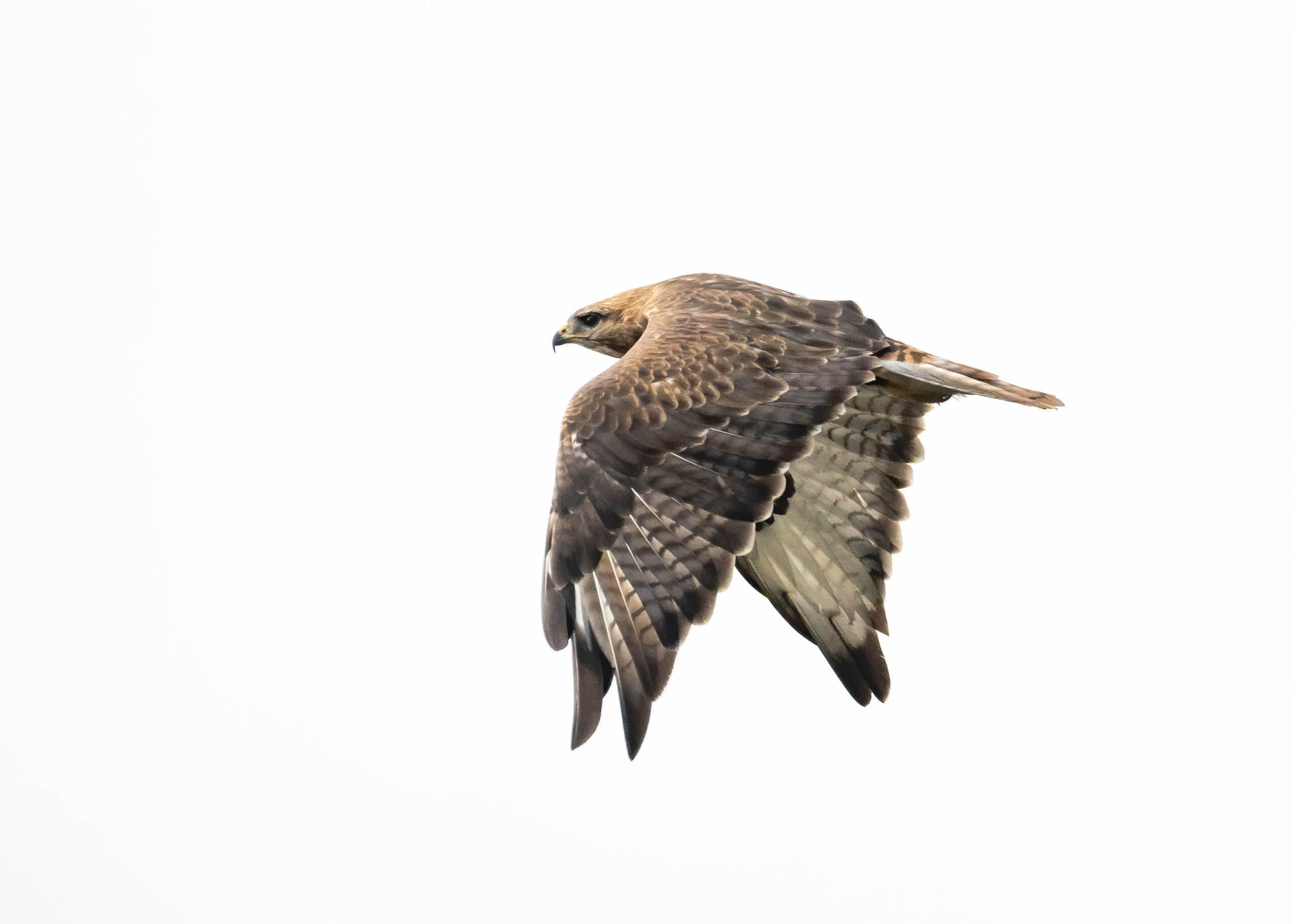
Scientific Name: Buteo rufinus
Conservation Status: Least Concern
This active and powerful predator is the largest species of bird in Buteo genus. This bird of prey is found in several parts of Eurasia and in north Africa. The habitat of Long-legged Buzzard is open uncultivated areas with high bushes, trees, cliffs or hillocks. Small mammals, birds and insects are hunted by this raptor of Assam.
-
Long-tailed Broadbill

Scientific Name: Psarisomus dalhousiae
Conservation Status: Least Concern
This beautiful bird is found in the Himalayas and the adjacent areas. The Long-tailed broadbill is overall bluish green with a yellow face and a helmet like black patch on the head. This bird normally forages in flocks; but sometimes seen singly.
-
Long-tailed Shrike

Scientific Name: Lanius schach
Conservation Status: Least Concern
This is one of the very widely distributed birds of Assam. This bird feeds on insects, lizards and rodents. It prefers dry and open habitat and seen perched prominently atop a bush or on a wire.
-
Malayan Night Heron

Scientific Name: Gorsachius melanolophus
Conservation Status: Least Concern
This bird is found in forests, especially near dry streams. This medium sized heron feeds on earthworm and frogs. It roosts on trees and in open areas. It breeds in Assam during summer season.
-
Mallard

Scientific Name: Anas platyrhynchos
Conservation Status: Least Concern
Mallard is a dabbling duck which migrates to Assam during winter. The male bird has grey-brown wings with a bottle green coloured head while the female is streaked brown in colour. This bird is found in the large water bodies of Assam during winter season. Hundreds of Mallards visit the Pobitora Wildlife Sanctuary, Assam during the winter season.
-
Maroon Oriole

Scientific Name: Oriolus traillii
Conservation Status: Least Concern
In India this oriole species is found in Himachal Pradesh and the northeastern states including Assam. Its natural habitat is subtropical or tropical moist lowland forest. This bird is sexually dimorphic. The male is of maroon and black plumage while the females are a little darker.
-
Northern Lapwing
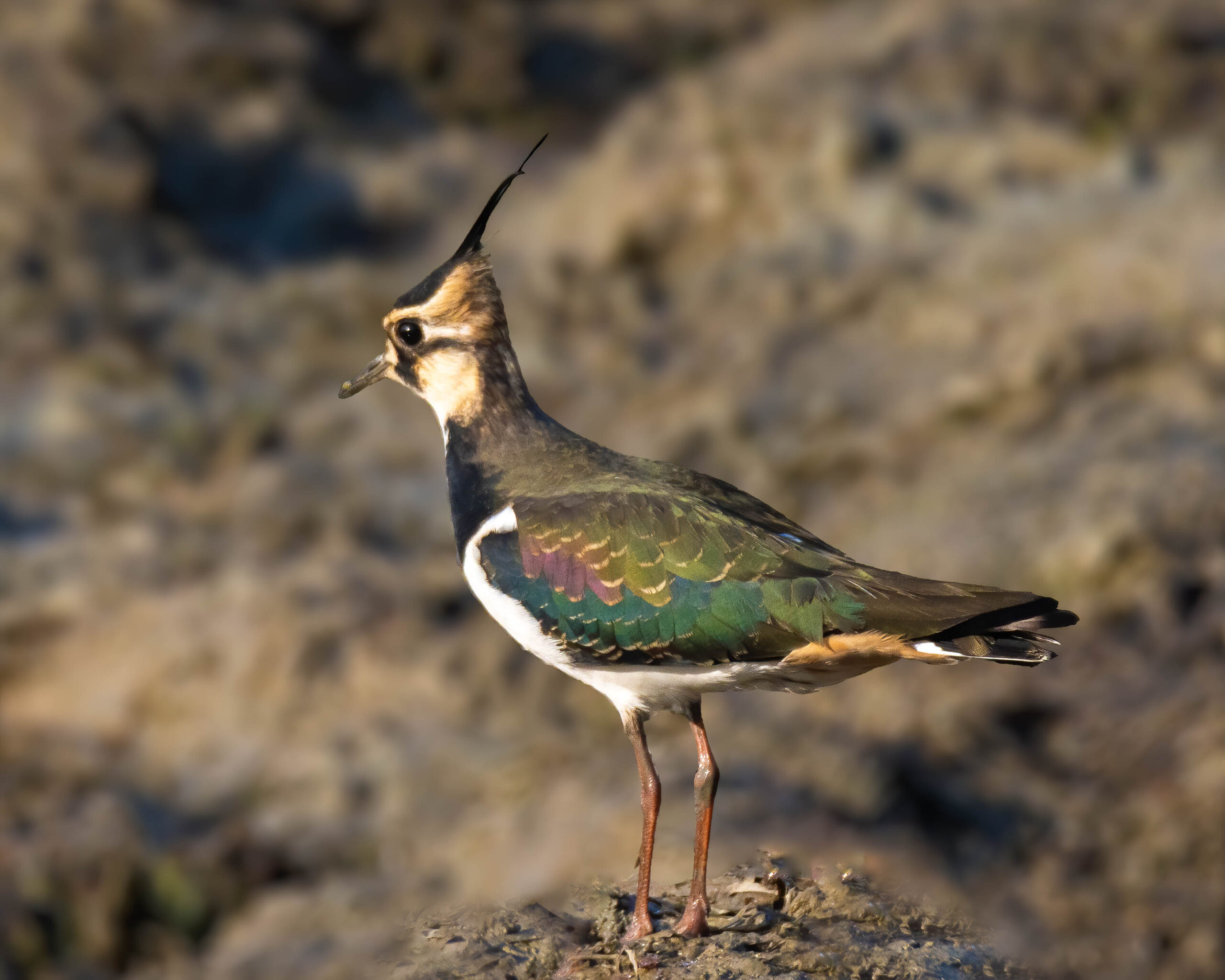
Scientific Name: Vanellus vanellus
Conservation Status: Near Threatened
The Northern lapwing is a wader bird. The colour of the bird is black and white; but the back is tinted green. The male bird has a long crest and black crown while the female and young bird has shorter crest. Northern lapwing feeds on insects and other small invertebrates. It often forages in mixed flocks with other water birds.
-
Northern Shoveler

Scientific Name: Spatula clypeata
Conservation Status: Least Concern
This duck is a winter migrant to Indian subcontinent including Assam. It prefers open wetlands as its natural habitat. The name of this bird derives from its shovel like bill. It feeds on varieties of aquatic plants by dabbling into the water. This is one of the commonly found winter migratory birds of Assam.
-
Olive-backed Pipit

Scientific Name: Anthus hodgsoni
Conservation Status: Least Concern
The back of this pipit species is olive coloured. This bird prefers open grasslands particularly near water body as its natural habitat. This bird is abundantly found in Assam during winter season.
-
Orange-bellied Leafbird

Scientific Name: Chloropsis hardwickii
Conservation Status: Least Concern
This is one of the three leafbird species found in Assam and a resident breeder of central and eastern Himalayas. In an overall bluish green plumage, the male bird has an orange belly. This bird feeds on insects, spiders and nectars.
-
Orange-headed Thrush

Scientific Name: Geokichla citrina
Conservation Status: Least Concern
The Orange-headed thrush is a bird of thrush family. It is a resident bird of the Indian subcontinent. It prefers shady and damp areas of well-wooded forests as its natural habitat. The male bird has a grey upper parts and orange head and under parts. The female has brown upper parts.
-
Oriental Bay Owl
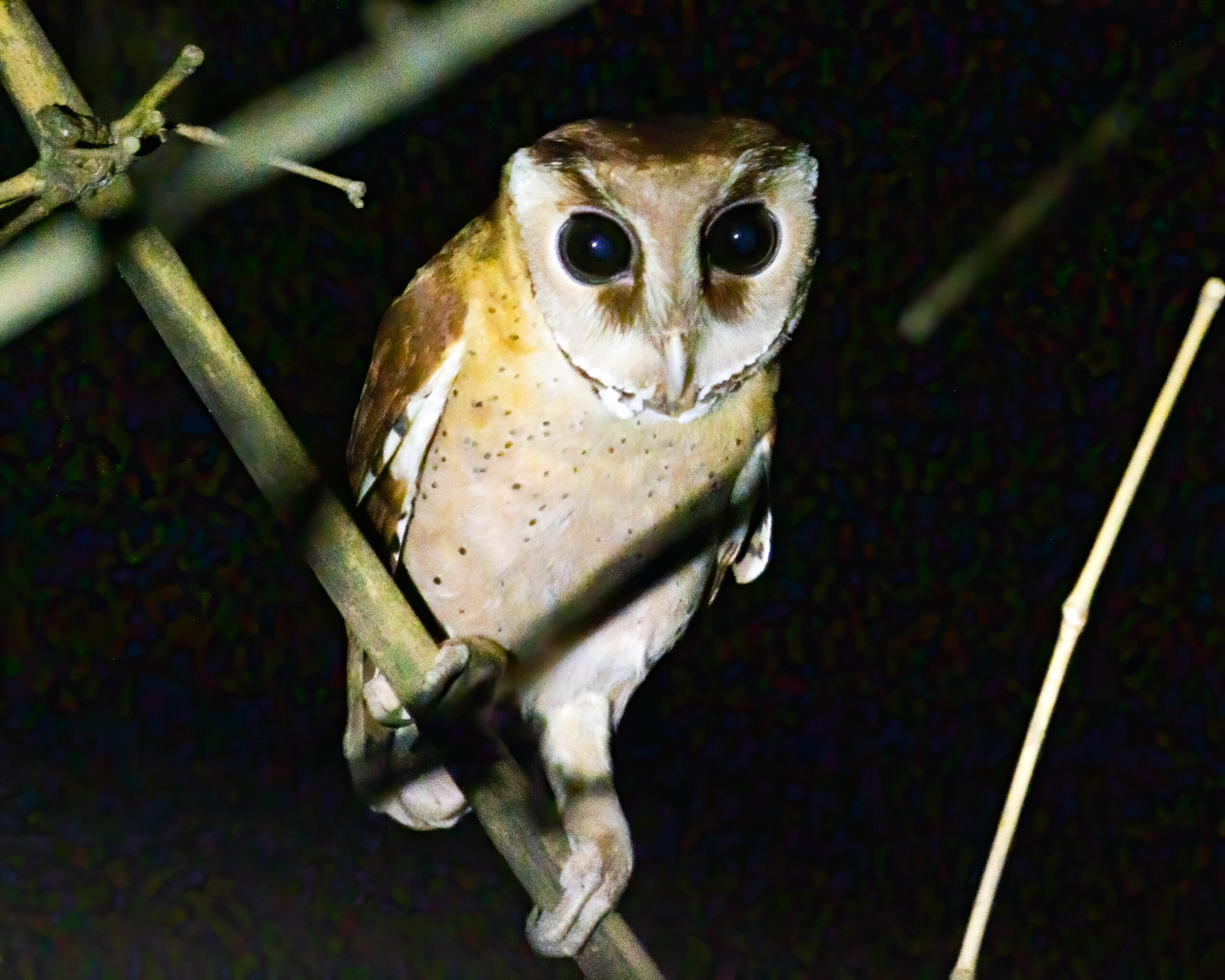
Scientific Name: Phodilus badius
Conservation Status: Least Concern
This completely nocturnal owl species is found in southeast Asia and in some parts of India including Assam. This bird has a triangular shaped face with earlike extensions. The Oriental Bay owl is a carnivorous bird and feeds on small rodents, bats, birds, snakes, frogs etc. This highly elusive owl is found at protected areas like the Garbhanga Reserve Forest, Dehing Patkai National Park etc. of Assam.
-
Oriental Darter

Scientific Name: Anhinga melanogaster
Conservation Status: Near Threatened
This water bird has a long and slender neck with a pointed and straight bill. It fishes by submerging its body into the water. Only the slender neck is visible while fishing. It spears a fish underwater, brings it above and tosses before gulping it. This bird is found in the natural waterbodies of Assam.
-
Oriental Dollarbird

Scientific Name: Eurystomus orientalis
Conservation Status: Least Concern
This is a bird of roller family. Because of its coin shaped spots on its wings, this bird is named as dollarbird. It prefers open woodlands as its natural habitat. This is an insectivorous bird found in the wooded habitats of Assam.
-
Oriental Dwarf Kingfisher

Scientific Name: Ceyx erithaca
Conservation Status: Least Concern
This pocket-sized kingfisher is very popular among the bird watchers. This bird is an inhabitant of tropical low land and breeds during the summer season in Assam. It feeds on lizards, insects, spiders, fishes etc. This bird is endemic to Indian Subcontinent and Southeast Asia.
Garbhanga Reserve Forest, Manas National Park, Rani Reserve Forest, Dehing Patkai National Park are some major habitats of this bird in Assam.
-
Oriental Magpie Robin

Scientific Name: Copsychus saularis
Conservation status: Least Concern
The Oriental Magpie Robin is the National Bird of Bangladesh. It is a resident breeder of Indian subcontinent and Southeast Asia. This bird is one of the most common and widespread birds of Assam. Oriental Magpie Robin is a songbird and an inhabitant of diverse habitats like urban area, forest land and cultivated land.
-
Oriental Pied Hornbill
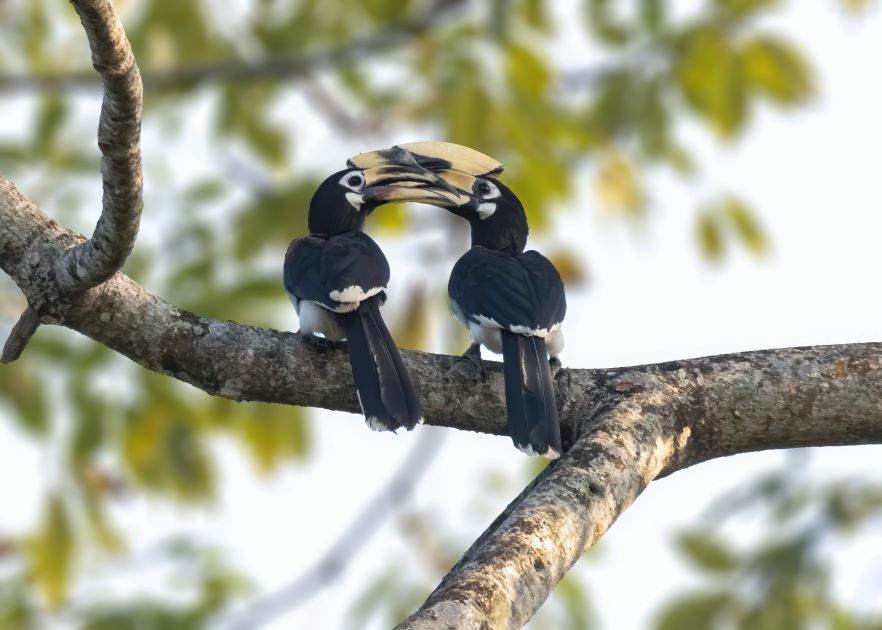
Scientific Name: Anthracoceros albirostris
Conservation Status: Least Concern
This medium sized hornbill is a resident bird of the Indian subcontinent and Southeast Asia. It feeds on fruits, insects, small reptiles etc. The Oriental Pied Hornbill is an excellent pollinator and it helps seed dispersal of plants in forests. This bird nests in the areas where there are plenty of fruits available. This is one of the widespread forest birds of Assam.
-
Oriental Scops Owl

Scientific Name: Otus sunia
Conservation Status: Least Concern
This small sized owl is found in eastern and southern Asia. This owl has ear tufts, which are not prominent in all the times. With a variable plumage morph, this owl is widely distributed in the dry deciduous forests from Russia to Thailand and one of the widely distributed birds of Assam.
-
Oriental Turtle Dove

Scientific Name: Streptopelia orientalis
Conservation Status: Least Concern
The Oriental Turtle Dove is a large forest dwelling dove species found in central and eastern Asia including Assam. This dove species is found in the forests of Assam. It is a herbivorous bird and feeds on varieties of seeds. It normally forages on the ground.
-
Osprey

Scientific Name: Pandion haliaetus
Conservation Status: Least Concern
This large fish-eating raptor is found in all the continents except Antarctica. They are residents of diversified habitats and nest near water bodies. An Osprey can spot an underwater fish by hovering over the waterbody and catches it with its claw by plunging into the water, sometimes submerging the whole body. This bird is found in the rivers and large waterbodies of Assam.
-
Pacific Golden Plover

Scientific Name: Pluvialis fulva
Conservation Status: Least Concern
The Pacific golden plover is a migratory bird which winters in Assam. This is a shorebird and prefers foraging in open land with short vegetations. It feeds on insects and berries. This bird is found in the open grasslands of Assam during winter season. This photograph of the male bird with breeding plumage was taken in the month of May, 2023 at Dorabeel, Assam.
-
Paddyfield Pipit

Scientific Name: Anthus rufulus
Conservation Status: Least Concern
This bird is a resident breeder of many parts of Asia including India. This pipit is very hard to be distinguished from other pipit species found in Assam. Paddyfield pipit is one of the widespread and easily found birds of Assam in comparison to the other pipit species found in the state of Assam.
-
Painted Stork

Scientific Name: Mycteria leucocephala
Conservation Status: Near Threatened
This beautiful bird is a large wader of the stork family found in Indian subcontinent and some other parts of Asia. Its distinctive pink tertial feathers on the body give the name of the bird. Painted stork forages in flocks in shallow water. This bird is found in the large waterbodies of Assam.
-
Pale-headed Woodpecker
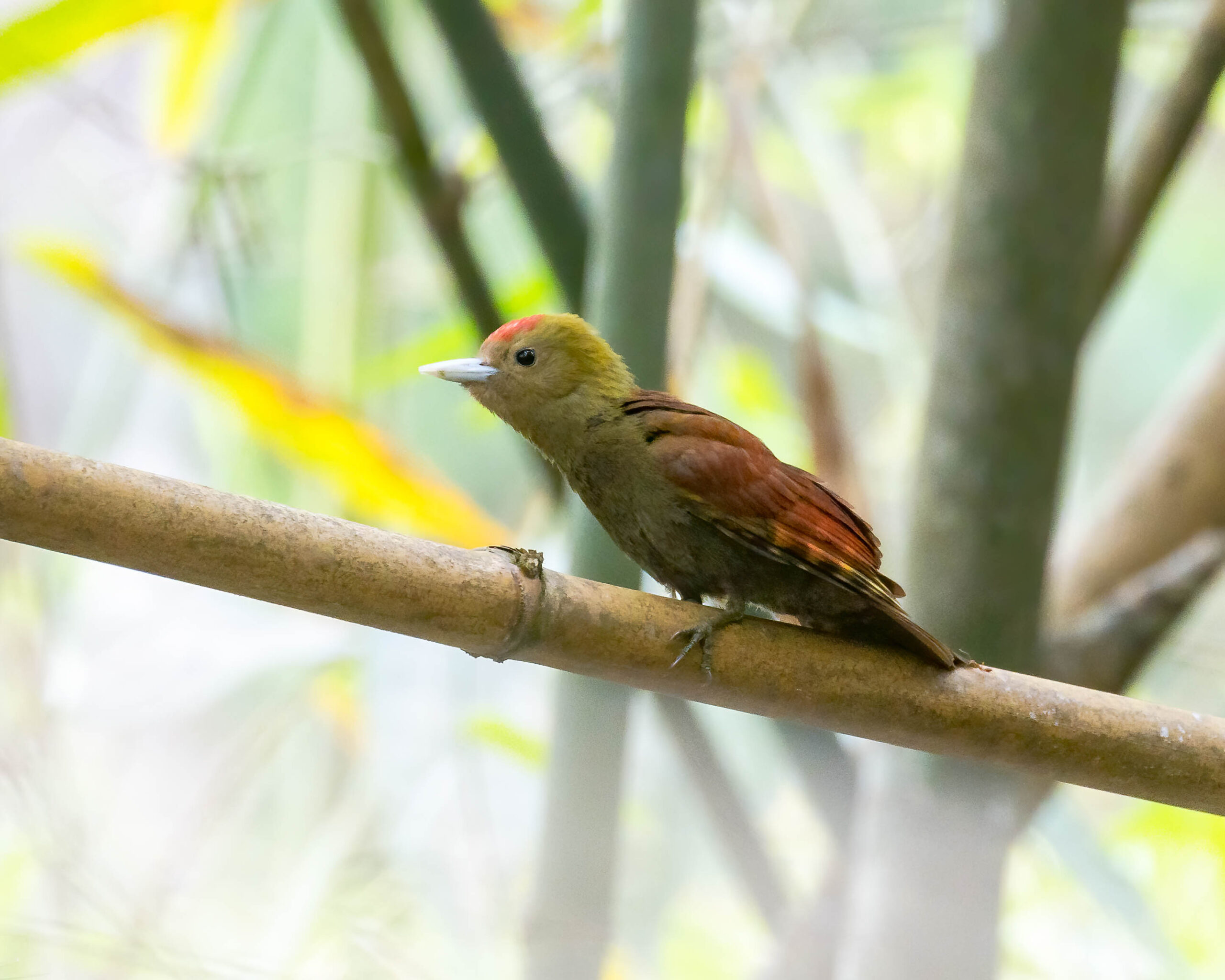
Scientific Name: Gecinulus grantia
Conservation Status: Least Concern
Pale-headed Woodpecker is a resident bird of the Indian subcontinent. This bird is a little elusive in comparison to the other woodpeckers. They are often heard drumming on bamboo in dense forest. This bird is found in the forests of Assam.
-
Pallas’s Fish Eagle

Scientific Name: Haliaeetus leucoryphus
Conservation Status: Endangered
The Pallas’s Fish Eagle is an Endangered species as per the IUCN Red list. This partially migratory large raptor is a resident breeder of the Indian subcontinent. As the name suggests, the primary diet of this bird is freshwater fish. Apart from fish, its other regular diet is birds, especially water birds. But sometimes it feeds on rodents, frogs, reptiles including snakes and insects. This bird is found in the Kaziranga National Park in Assam.
-
Peregrine Falcon

Scientific Name: Falco peregrinus
Conservation Status: Least Concern
This is a cosmopolitan bird of prey in the family Falconidae. The Peregrine Falcon is the fastest member of the animal kingdom. The diving speed of this bird is 320 kmph (200 mph). But as per the National Geographic TV, the highest measured speed of Peregrine Falcon is 389 kmph (242 mph). This lightning-fast falcon feeds on small to medium sized birds. Like some other falcons, Peregrine Falcon is also sexually dimorphic and the females are considerably larger than the males.
-
Pheasant-tailed Jacana

Scientific Name: Hydrophasianus chirurgus
Conservation Status: Least Concern
This beautiful water bird can easily walk over the leaves of floating vegetation due to its elongated nails and toes. They are good swimmers and are generally found in wetlands. The female bird is a bit larger than the male. During the breeding season, their colour becomes more prominent and the tail becomes a little longer than the non-breeding time. This is one of the widely distributed aquatic birds of Assam.
-
Pied Kingfisher

Scientific Name: Ceryle rudis
Conservation Status: Least Concern
The Pied Kingfisher is widely distributed in Asia and Africa. They breed anytime during the year. They feed on fishes and for this, they adapt a unique fishing style. This bird observes underwater fish by hovering over the water body. When a fish is spotted, it dives vertically closing the wings and catches the fish with its strong bill and eats at a safe place. This is one of the easily found kingfishers of Assam.
-
Pin-striped Tit-babbler

Scientific Name: Mixornis gularis
Conservation Status: Least Concern
This babbler is found in the south and southeast Asia including India. This is one of the widely distributed birds of Assam. This bird is found in all the forests of Assam.
-
Plain Prinia

Scientific Name: Prinia inornata
Conservation Status: Least Concern
This bird is a resident breeder of India. It has short rounded wings, a longer tail, strong legs and a short black bill. Its natural habitat is wet lowland grassland and open woodland. The Plain prinia is an insectivorous bird.
-
Plaintive Cuckoo

Scientific Name: Cacomantis merulinus
Conservation Status: Least Concern
The Plaintive cuckoo is a small cuckoo species found in Assam which is known for its plaintive whistling call. This cuckoo feeds on insects, caterpillars and spiders. It inhabits forest edges, open woodlands, scrubs, grasslands and farmlands. Plaintive cuckoo is a brood parasite and chooses cisticolas, prinias and tailorbirds as its hosts. This is one of the widely distributed cuckoos of Assam.
-
Puff-throated Babbler

Scientific Name: Pellorneum ruficeps
Conservation Status: Least Concern
This is a resident breeder of Asia. This bird forages in flock on the ground and lower level of moist forests. Puff-throated babbler is also known as Spotted babbler.
-
Pygmy Cupwing

Scientific Name: Pnoepyga pusilla
Conservation Status: Least Concern
This is a bird of wren-babbler family. The Pygmy cupwing is a super skulker dwelling in the dense and shady undergrowth of subtropical or tropical moist lowland forests. This bird has two colour morphs, white morph and rufous morph.
-
Red Jungle Fowl

Scientific Name: Gallus gallus
Conservation Status: Least Concern
This resident breeder of South and Southeast Asia looks like the domesticated chicken. The only difference is that their tail is a little longer and they can fly high like other birds. The ‘Red Jungle Fowl’ is the ancestor of our domesticated chicken. The male ‘Red Jungle Fowl’ is predominantly red in color and larger than the female. The female is brown and her tail is a little shorter than that of the male. It is one of the common birds of Assam which resides in dense forest.
-
Red-throated Flycatcher (Taiga)

Scientific Name: Ficedula albicilla
Conservation Status: Least Concern
The Red-throated Flycatcher or Taiga flycatcher is a winter visitor to Assam. The breeding male bird has an orange red patch under the throat. But the female lacks such red patch. This flycatcher is one of the widespread birds of Assam during winter.
-
Red-breasted Parakeet
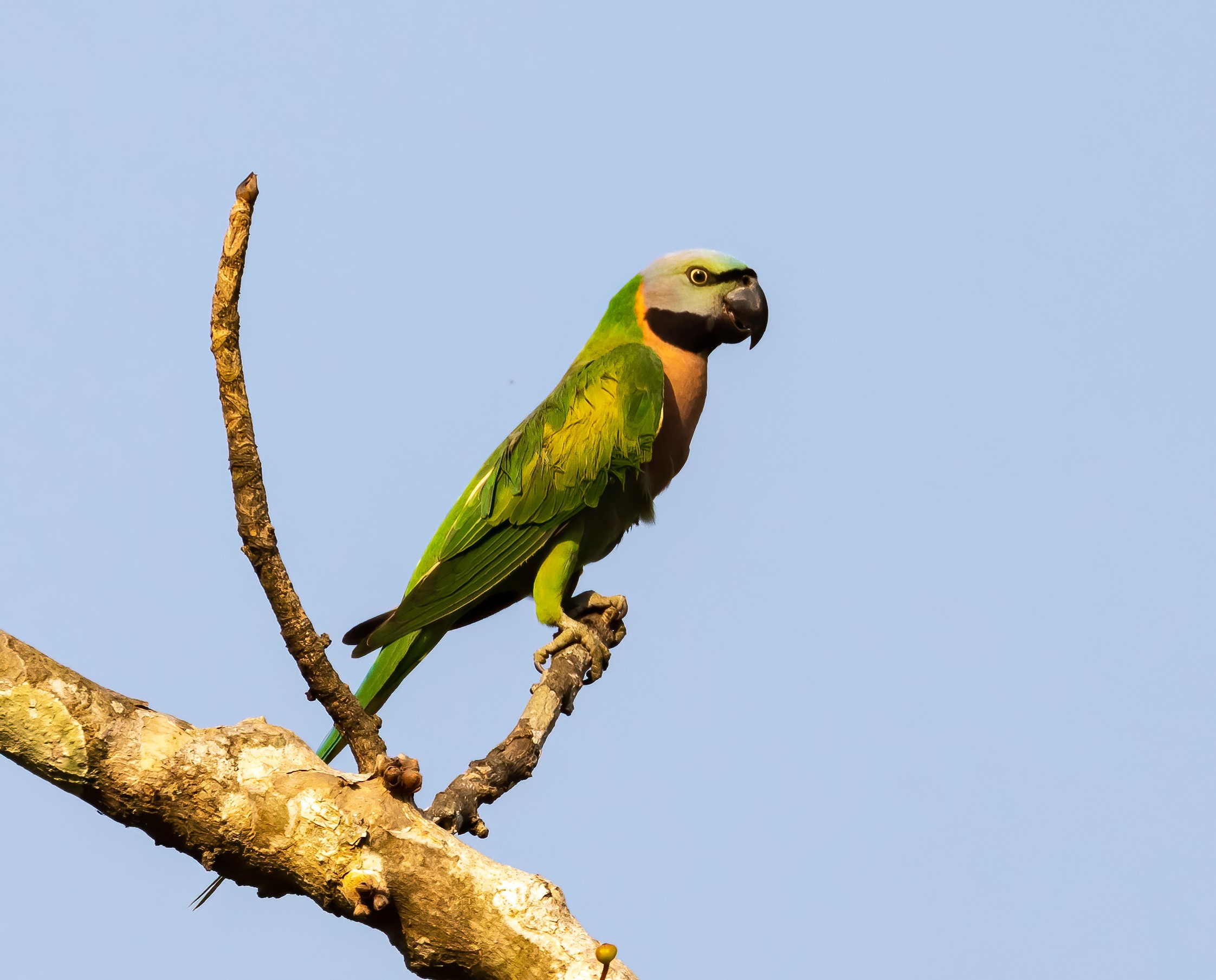
Scientific Name: Psittacula alexandri
Conservation Status: Near Threatened
This is a parrot species native to southeast Asia. This bird can be easily identified for its red patch on the breast. The Red-breasted Parakeet is a near threatened species as per the IUCN Red list. This bird is found in all types of forests of Assam.
-
Red-crested Pochard

Scientific Name: Netta rufina
Conservation Status: Least Concern
This large diving duck breeds in southern Europe and winters in Africa and the Indian subcontinent including Assam. The adult male bird is unmistakable with a rounded orange head and a red bill. However, the female is pale brown in colour. This bird is found in the large waterbodies of Assam during winter season.
-
Red-vented Bulbul
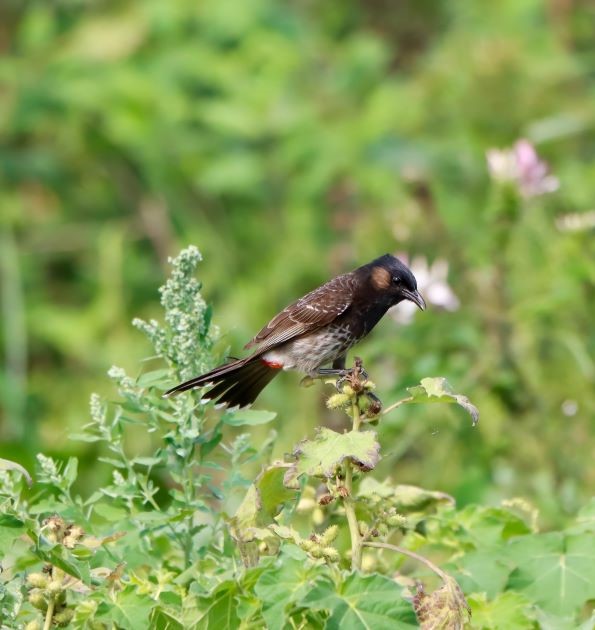
Scientific Name: Pycnonotus cafer
Conservation Status: Least Concern
This resident breeder of Indian subcontinent is very much widespread and omnipresent in Assam. This bird is an inhabitant of forests and proximate human habitations and easily found in the cities and towns of Assam as well. This is one of the most widely distributed bulbuls of Assam. In ancient times, ‘Bulbul fight’s (‘Bulbuli juj’ in Assamese) were organized traditionally at Hajo, Assam. However, this has been legally banned by the Indian law.
-
Red-wattled Lapwing
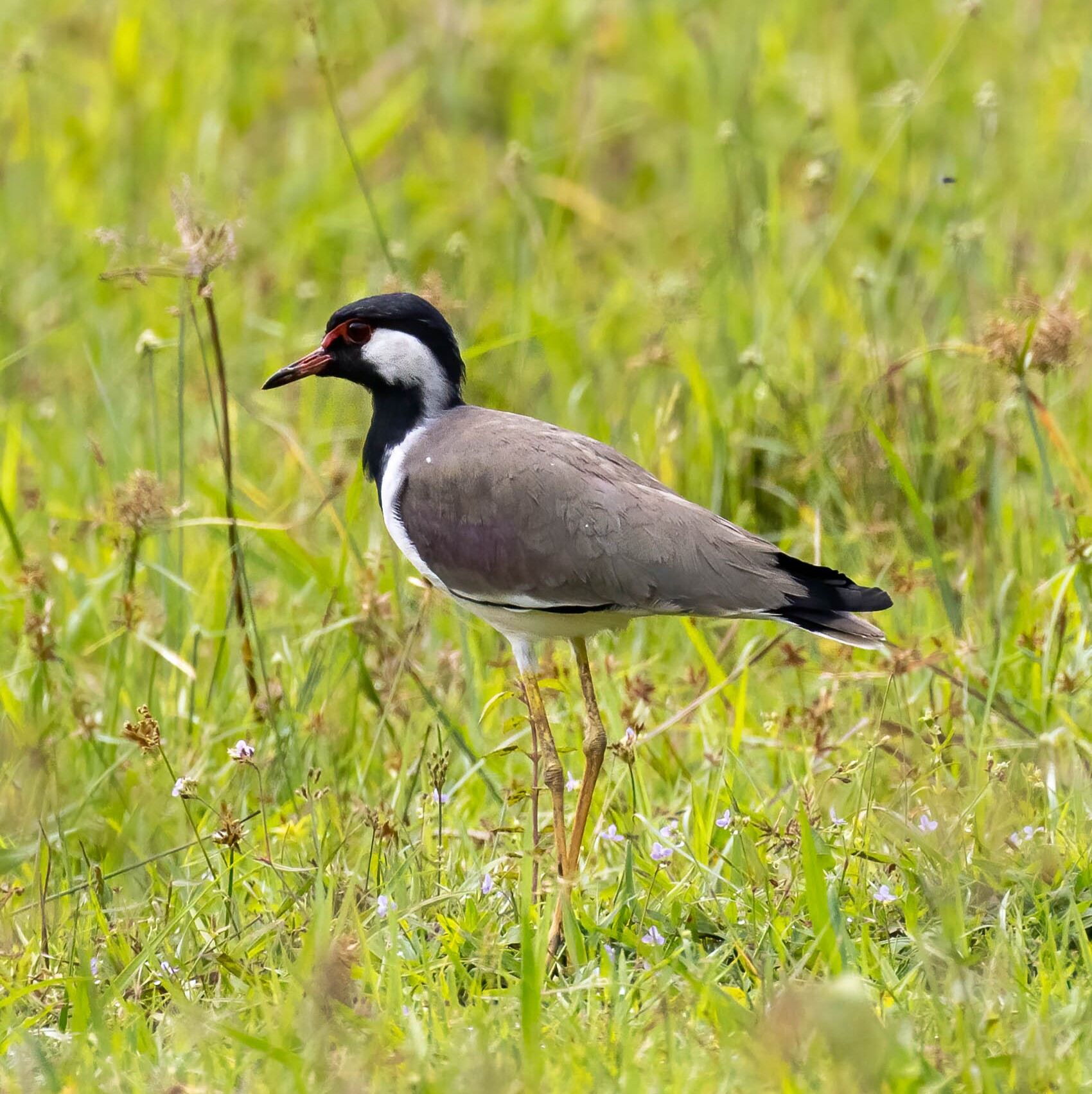
Scientific Name: Vanellus indicus
Conservation Status: Least Concern
The Red-wattled Lapwing is the most common lapwing of Assam. Like other lapwings, this is also a ground nesting bird which cannot perch on a branch This bird is very much vocal and it becomes noisier when any human being or other animal approaches its nest. This bird is found in all the wetlands of Assam.
-
Red-whiskered Bulbul
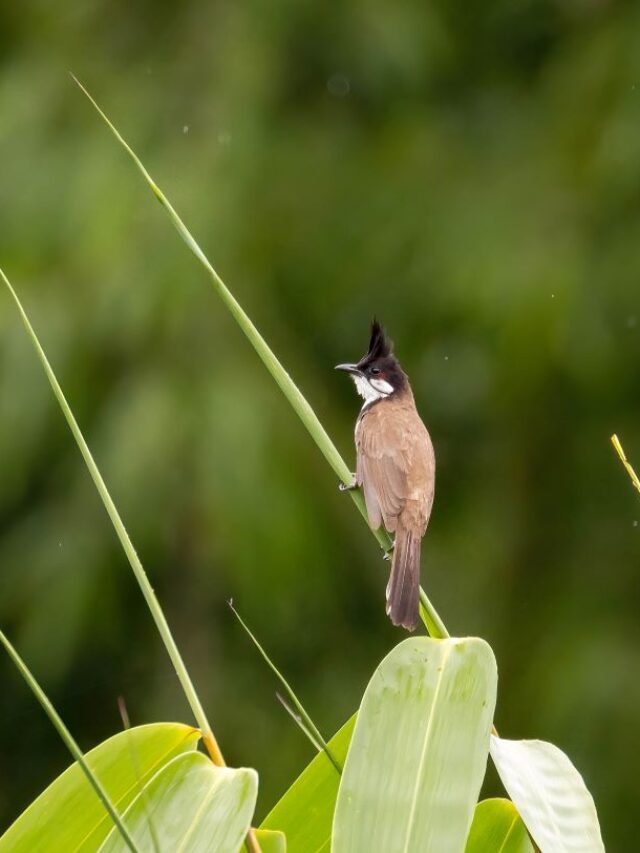
Scientific Name: Pycnonotus jocosus
Conservation Status: Least Concern
This is a resident breeder available in both plain and high-altitude areas of Assam. This bird looks like the ‘Red Vented Bulbul’ except the prominent crest and the bright red patches near both the ears. This bird is found in all type of forests of Assam.
-
River Lapwing
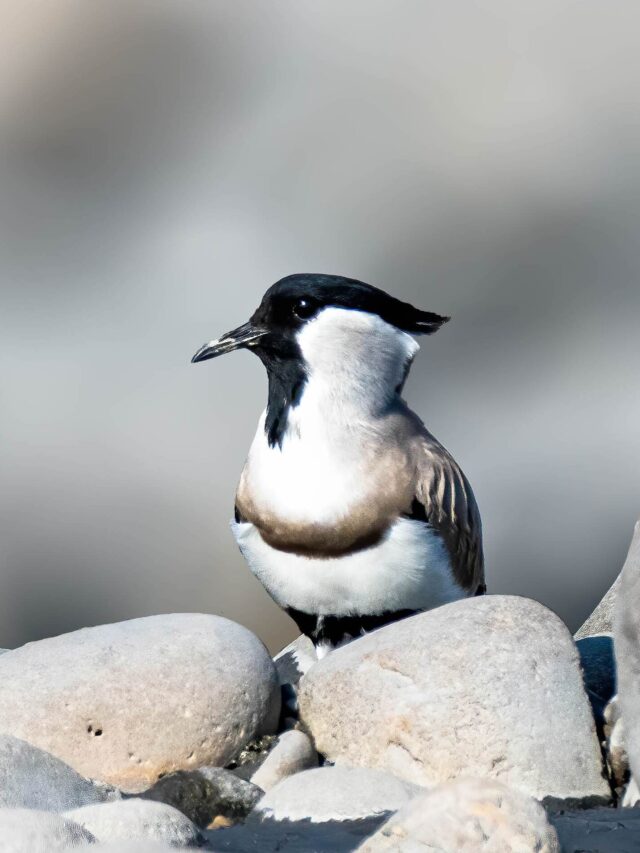
Scientific Name: Vanellus duvaucelii
Conservation Status: Near Threatened
This bird has grey-white wings and a prominent black crest. Due to human pressure on riverine ecosystem and construction of hydropower projects, the global population of River lapwing is anticipated to undergo a moderately rapid declination in the upcoming generations. Therefore, the IUCN has enlisted this species as Near Threatened in their Red list. This bird is found in the rivers of Assam.
-
Rose-ringed Parakeet

Scientific Name: Psittacula krameri
Conservation Status: Least Concern
This parrot is resident to the Indian subcontinent and one of the widespread birds of Assam. This bird feeds on buds, fruits, vegetables, nuts, berries and seeds. This is the most common parrot species found in Assam.
-
Ruby-cheeked Sunbird

Scientific Name: Chalcoparia singalensis
Conservation Status: Least Concern
This is a bird of sunbird family found in Indian subcontinent including Assam. The natural habitat of this bird is subtropical or tropical moist lowland forest. This bird is sexually dimorphic. It feeds on insects, caterpillars and nectar.
-
Ruddy Shelduck

Scientific Name: Tadorna ferruginea
Conservation Status: Least Concern
Ruddy Shelduck or Brahminy Duck is one of the well-known birds of Assam. This bird migrates to Assam during winter season. It is normally seen in a pair; but sometimes forages in large flock in various lakes, rivers and other large waterbodies of Assam. A little larger than the domesticated duck, this bird is saffron colored with a white patch on the head. Ruddy Shelduck is basically a nocturnal bird, but forages in daytime as well.
-
Ruddy-breasted Crake

Scientific Name: Zapornia fusca
Conservation Status: Least Concern
The Ruddy-breasted Crake is a water bird in the rail and crake family. This bird forages in mud or shallow water. It feeds on shoots, berries and insects. Both the sexes are similar. But the juveniles are dark brown with some white spotting. This bird is found in the wetlands of Assam.
-
Rufescent Prinia

Scientific Name: Prinia rufescens
Conservation Status: Least Concern
This prinia is found in the Indian subcontinent and southeast Asia. Its natural habitats are subtropical or tropical dry forests.
-
Rufous Woodpecker

Scientific Name: Micropternus brachyurus
This beautiful medium-sized woodpecker is often seen foraging in pair or sometimes singly. This bird normally feeds on ants; but sometimes it is seen collecting nectar from flowers. Lowland forests are the natural habitat of Rufous woodpecker. This woodpecker is found in the forests of Assam.
-
Russet Sparrow

Scientific Name: Passer cinnamomeus
Conservation Status: Least Concern
This is a passerine bird of the sparrow family. This seed eating sparrow is found in eastern Asia and in the Himalayas. This bird is found in the Manas National Park of Assam.
-
Scarlet Minivet

Scientific Name: Pericrocotus speciosus
Conservation Status: Least Concern
This bird is a resident breeder of Indian subcontinent. The natural habitat of Scarlet minivet is well wooded forests and gardens, especially in hilly areas. Both the sexes are different in colour. The male is scarlet to red with black upper part and the female is predominantly yellow with grey upper parts. This is one of the easily found birds of Assam.
-
Scarlet-backed Flowerpecker

Scientific Name: Dicaeum cruentatum
Conservation Status: Least Concern
This pocket-sized bird is a resident bird of Assam. Both the sexes are dimorphic. The male is dark blue colored with a scarlet patch on the back covering head to tail. The female and the juveniles are green without any scarlet patch. Their habitat is subtropical or tropical moist lowland. They are also seen near human habitations. This bird feeds on varieties of fruits and seeds.
-
Short-eared Owl

Scientific Name: Asio flammeus
Conservation Status: Least Concern
This medium sized grassland owl is seen active during daytime as well. Its short ear tufts are normally not visible. But when it comes to a defensive mood, it displays the tufts prominently. This owl is seen flying lazily in search of prey in the open grasslands and paddy fields of Assam. This owl is a resident breeder of Assam.
-
Siberian Rubythroat

Scientific Name: Calliope calliope
Conservation Status: Least Concern
The Siberian Rubythroat breeds in Siberia and winters in Thailand, Indonesia, Bangladesh and India including Assam. The male bird has a ruby-coloured patch on its neck in an overall grey body. But the female lacks such patch.
-
Siberian Stonechat

Scientific Name: Saxicola maurus
Conservation Status:
This is a migratory bird to Assam which breeds in Siberia and migrates during winter season. Siberian Stonechat is widely populated in Assam in open grasslands, cultivated lands and bushes. This bird is sexually dimorphic, the male having black wings and head with orange and white patch in the underparts. The females are pale brown in color. This is one of the most widely distributed birds of Assam during winter.
-
Silver-breasted Broadbill

Scientific Name: Serilophus lunatus
Conservation Status: Least Concern
The Silver-breasted broadbill is a resident bird of the Indian subcontinent including Assam. Its natural habitat is subtropical or tropical moist lowland forest and subtropical or tropical montane forest. The population of this bird has been declining due to habitat loss in recent years. But such declination is not yet very serious and that is why this bird is considered as a Least concern species in the IUCN red list.
-
Slaty-backed Flycatcher

Scientific Name: Ficedula erithacus
Conservation Status: Least Concern
This flycatcher is native to Indian subcontinent including Assam. The natural habitat of this bird is subtropical or tropical moist lowland forest.
-
Slaty-bellied Tesia

Scientific Name: Tesia olivea
Conservation Status: Least Concern
Slaty-bellied Tesia is a skulker and very difficult to see. It forages in the shady undergrowth of dense forests. This tiny bird is a winter visitor to the forests of Assam.
-
Small Niltava

Scientific Name: Niltava macgrigoriae
Conservation Status: Least Concern
This songbird is native to Indian subcontinent and southeast Asia. This bird is sexually dimorphic. The male bird is bright blue and the female is brown. The Small Niltava is a winter visitor to Assam and one of the widely distributed birds of Assam.
-
Small Pratincole

Scientific Name: Glareola lactea
Conservation Status: Least Concern
This is a resident breeder of the Indian subcontinent. This bird breeds in the winter season and nests in rocky and sandy banks of rivers or lakes. With a pair of short legs and long pointed wings, this bird looks like a Swift in flight. It normally forages on the ground of river banks and feeds on insects. This bird is also one of the widely distributed birds of Assam.
-
Snowy-browed Flycatcher

Scientific Name: Ficedula hyperythra
Conservation Status: Least Concern
This flycatcher forages lower level of the forests than any other flycatchers. This is a winter visitor to Assam. Snowy-browed Flycatcher is sexually dimorphic. The sharp whistling call of this bird can be heard from a long distance.
-
Speckled Piculet

Scientific Name: Picumnus innominatus
Conservation Status: Least Concern
Speckled piculet is the smallest woodpecker species found in India. This is a bird of Picidae family. Its colour pattern of the chest justifies the nomenclature of the bird. Normally Speckled piculet forages in pair in thin branches of the trees. Sometimes they are seen hanging on a branch upside down.
-
Spot-bellied Eagle Owl
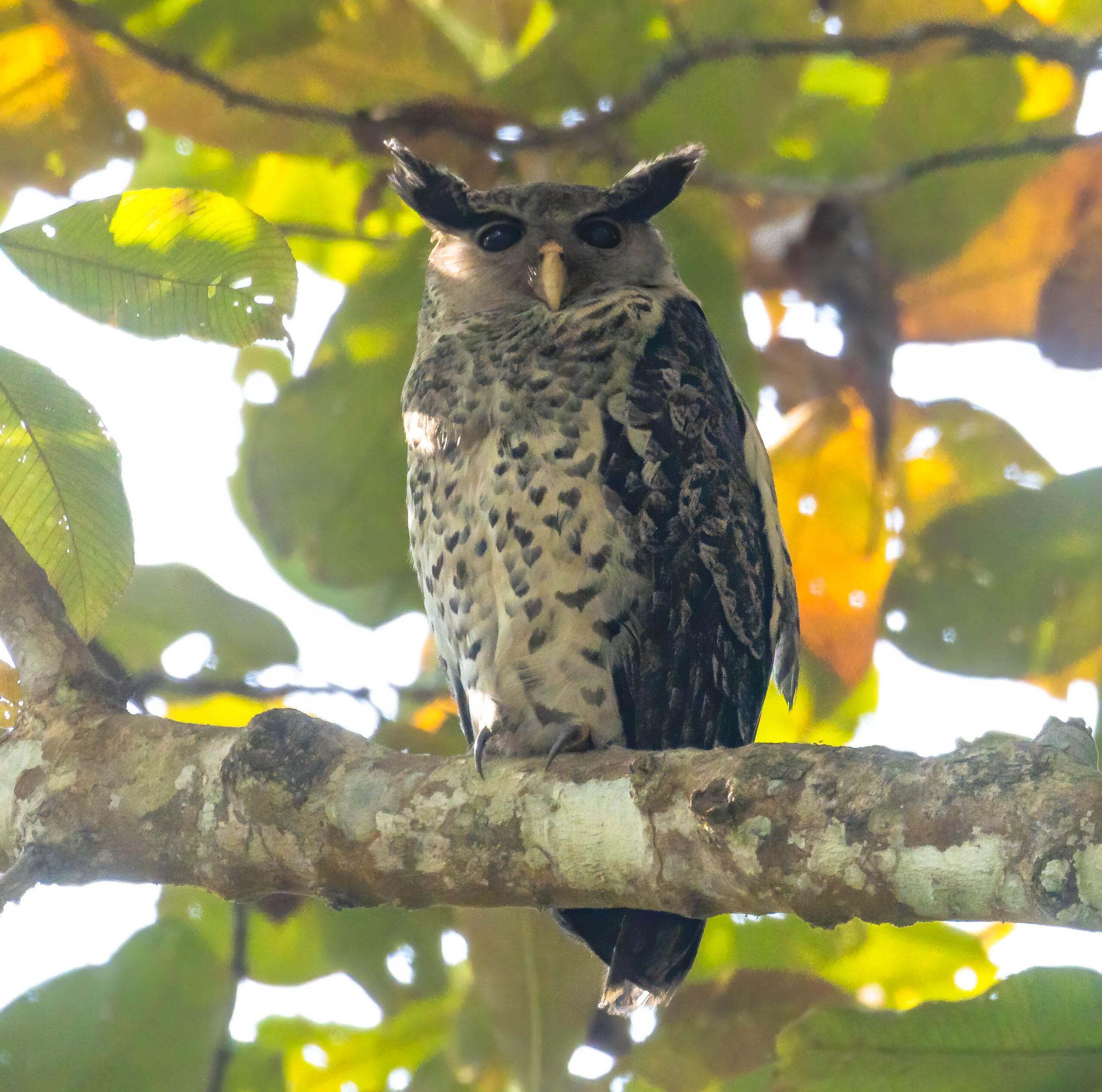
Scientific Name: Ketupa nipalensis
Conservation Status: Least Concern
The Spot-bellied Eagle Owl is a large owl which is the sixth longest owl species in the world. This is a nocturnal bird and an expert predator. The call of this bird is strange and ghostly. The meaning of the Assamese name of this bird is ‘caller of the devil’.
-
Spot-billed Pelican

Scientific Name: Pelecanus philippensis
Conservation Status: Near Threatened
This is a wader bird with a massive bill and body. This bird is found near lakes and other large water bodies. This is not a migratory bird, but sometimes it changes places locally. This bird nests in small trees near the water bodies. Population of this bird is decreasing due to habitat loss and anthropogenic pressure. In some places of Asia, this bird has already been extinct from wild.
-
Spotted Owlet

Scientific Name: Athene brama
Conservation Status: Least Concern (Population stable)
This small-sized owl is a resident breeder of Assam. The habitat of this bird is diversified from forests to human habitations including towns and cities. This bird is a common one in Assam. Though they are nocturnal, often could be seen in broad daylight. They become more active during night time. This is one of the most easily found owls of Assam.
-
Square-tailed Drongo Cuckoo

Scientific Name: Surniculus lugubris
Conservation Status: Least Concern
The Square-tailed Drongo Cuckoo is a cuckoo species similar to the Black drongo. This bird is found in the Himalayas and in southeast Asia including Assam.
-
Stork-billed Kingfisher

Scientific Name: Pelargopsis capensis
Conservation Status: Least Concern
This is the largest kingfisher found in Assam. As the other kingfishers, the ‘Stork Billed Kingfisher’ also nests near water bodies such as lakes, rivers etc. It feeds on fish, frog and other aquatic invertebrates. The wings and the tail portion of an adult bird are blue and the back is green. Both the sexes are alike. It normally chooses a particular area for regular fishing.
-
Streaked Spiderhunter
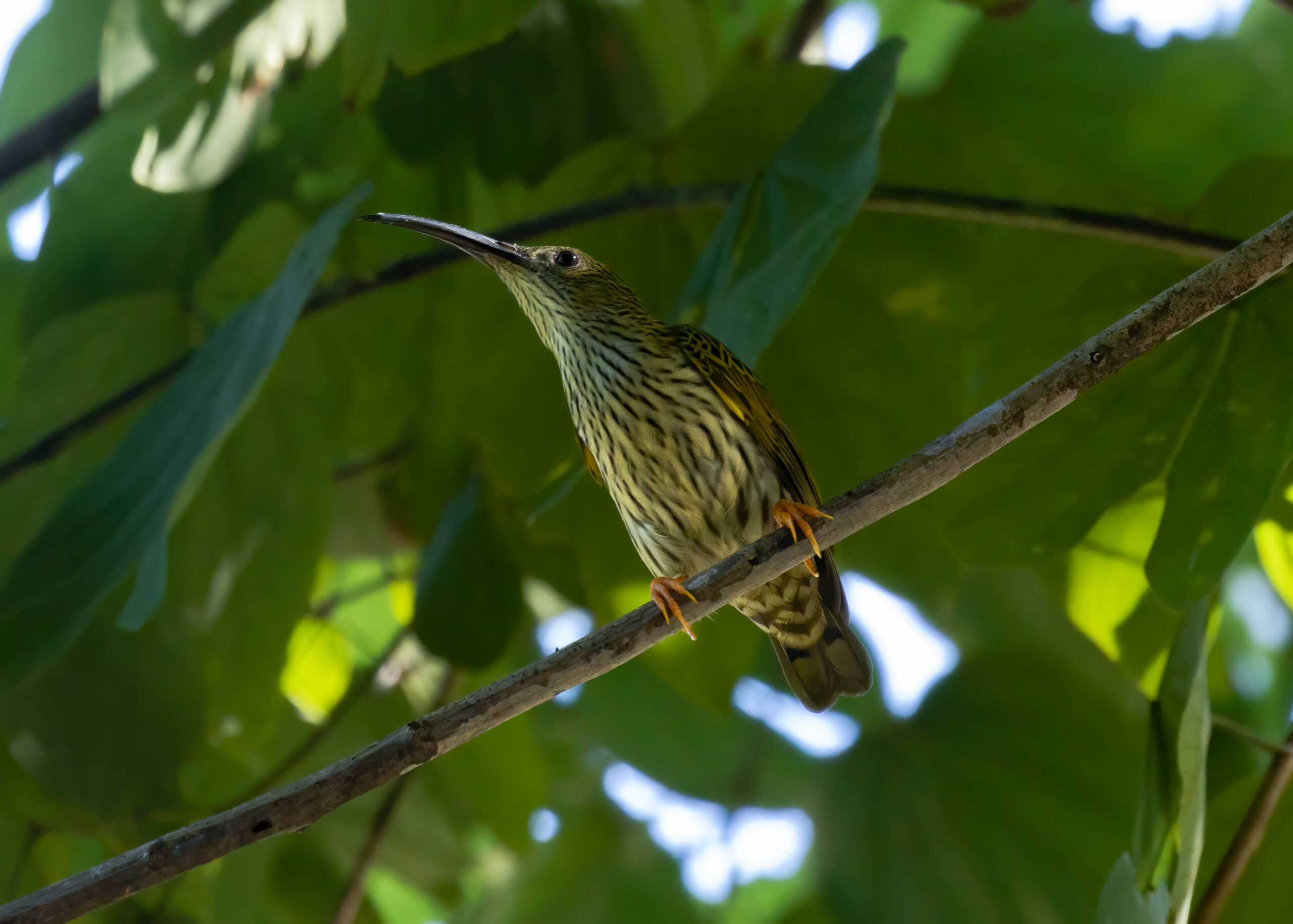
Scientific Name: Arachnothera magna
Conservation Status: Least Concern
This is a noisy bird of subtropical or tropical moist forests. This bird is unmistakable with its black streaks on yellow green under parts. The beak is long and curved. Streaked Spiderhunter normally feeds on nectar and insects.
-
Striated Heron

Scientific Name: Butorides striata
Conservation Status: Least Concern
This small-sized heron is widespread much of the world. It is seen stalking around the rivers, lakes and other wetlands. This heron is a widespread bird of Assam.
-
Sultan Tit

Scientific Name: Melanochlora sultanea
Conservation Status: Least Concern
This beautiful forest dweller has a prominent yellow crest in black upper parts and yellow under parts. In India this bird is found in lower Himalayas including the forests of Assam. This bird is very much vocal and forages in small flocks; sometimes in mixed flocks.
-
Swamp Francolin

Scientific Name: Ortygornis gularis
Conservation Status: Vulnerable (population decreasing)
This francolin prefers wet and marshy habitats like wetland edges and flooded areas. Earlier this bird was a common sighting in Assam. But due to various reasons, the population of Swamp Francolin has been declining. At present this bird is a Vulnerable species as per the IUCN Red list.
-
Thick-billed Green Pigeon

Scientific Name: Treron curvirostra
Conservation Status: Least Concern
The natural habitat of this beautiful bird is subtropical or tropical moist lowland forest. This bird is one of the widespread and common birds of Assam.
-
Velvet-fronted Nuthatch

Scientific Name: Sitta frontalis
Conservation Status: Least Concern
This is a small passerine bird in the nuthatch family. With a typical nuthatch body shape, this bird forages on the trunk and branches of trees. It feed on insects and bark of trees.
-
Verditer Flycatcher

Scientific Name: Eumyias thalassinus
Conservation Status: Least Concern
This blue-coloured flycatcher forages above the canopy level. It is found in the Himalayas through southeast Asia to Sumatra. This is one of the most found birds of Assam.
-
Whiskered Tern

Scientific Name: Chlidonias hybrida
Conservation Status: Least Concern
This bird breeds in Assam during summer season. It inhabits in large water bodies and wetlands. Whiskered Tern feeds on small fishes and other small aquatic invertebrates. Its plumage is silver in colour which becomes smoky during breeding season.
-
White Wagtail

Scientific Name: Motacilla alba
Conservation status: Least Concern
This beautiful black and white bird breeds in Europe and some parts of Asia. It migrates to India including Assam during the winter season. This bird inhabits near waterbodies and feeds on insects, caterpillars, snails etc. It forages in open land. This bird has a habit of wagging the tail constantly and that is why it is named as Wagtail.
-
White-bellied Erpornis

Scientific Name: Erpornis zantholeuca
Conservation Status: Least Concern
The natural habitat of this vocal bird is subtropical or tropical montane forest. This crested Yuhina like bird normally forages in mixed flocks.
-
White-browed Piculet

Scientific Name: Sasia ochracea
Conservation Status: Least Concern
With a distinct white eyebrow, this tiny bird is a resident breeder of the Indian subcontinent. The natural habitat of this piculet is dense forest with plenty of bamboos, scrubs and swampy woodland. As per studies, the population of this bird is stable at present. There is no apparent threat to this species and hence this bird is listed as Least Concern in the IUCN Red list.
-
White-capped Redstart
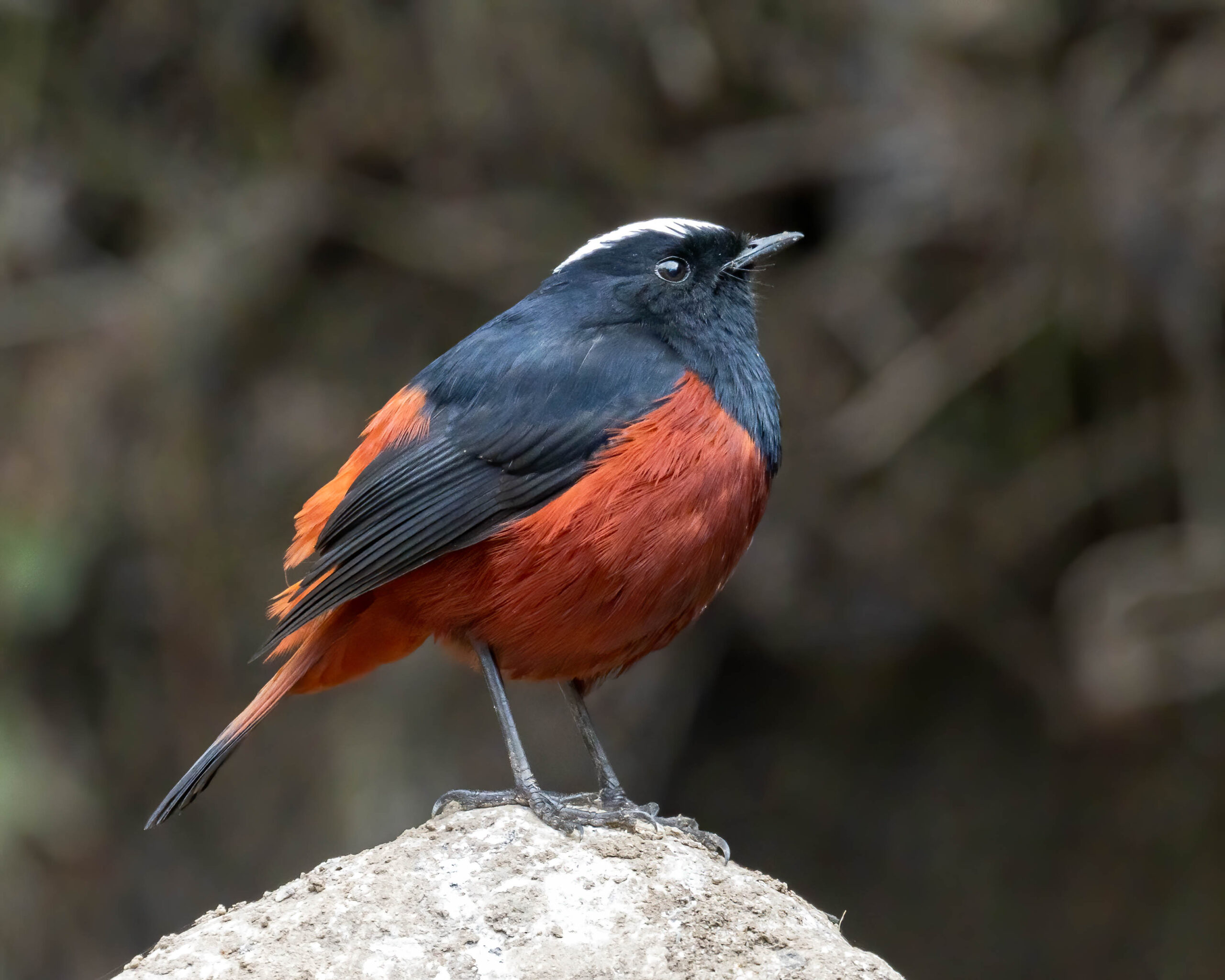
Scientific Name: Phoenicurus leucocephalus
Conservation Status: Least Concern
The White-capped Redstart is a native bird to the Indian subcontinent and southeast Asia. The colour of this bird is black with wine red belly and tail and a distinct white cap. Both the sexes of this bird are similar.
-
White-cheeked Partridge

Scientific Name: Arborophila atrogularis
Conservation Status: Near Threatened
This bird is found in northeast India, northern Myanmar and northeast Bangladesh. Like all other partridge species, this is a very shy bird and rarely seen in open. This bird is classified as Near Threatened species in the IUCN Red list because of the threat due to its habitat loss.
-
White-rumped Shama

Scientific Name: Copsychus malabaricus
Conservation Status: Least Concern
This is a resident bird of the Indian subcontinent and Southeast Asia. This bird lives in dense forests. The male bird is glossy black with chestnut colored underpart and a white patch on the rump. The female is greyish brown and a little smaller in size than the male. This bird has a special quality of imitating the calls of other birds in the forest.
-
White-rumped Vulture

Scientific Name: Gyps bengalensis
Conservation Status: Critically Endangered (Population decreasing)
Historically this bird was widely distributed in entire Southeast Asia till nineties. However, its population has been steeply declining and at present, the bird is declared as Critically Endangered by the International Union for Conservation of Nature (IUCN). Once upon a time, this bird was a very common sight in Assam. But unfortunately for various reasons, now it has become rare.
-
White-throated Bulbul
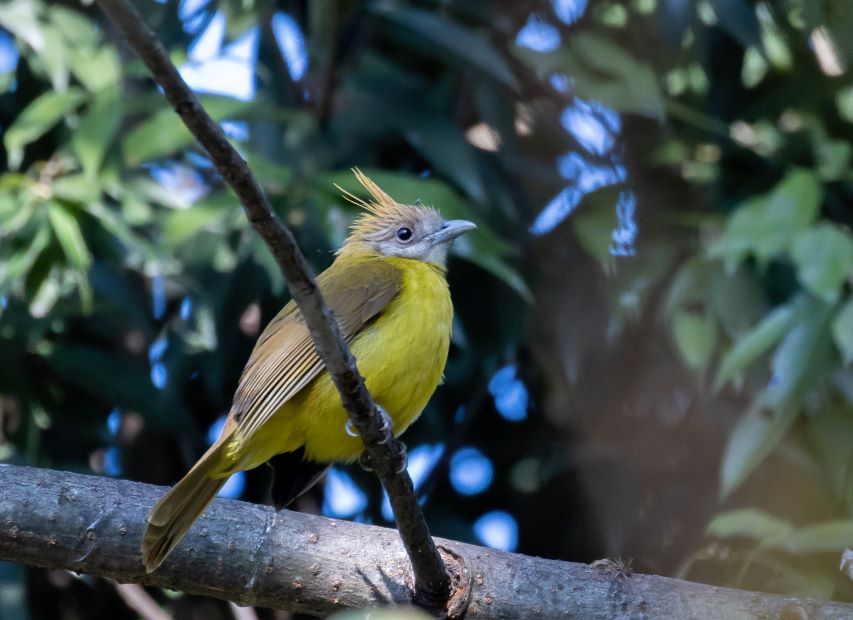
Scientific Name: Alophoixus flaveolus
Conservation Status: Least Concern
This Bulbul is common in the forests of Assam. A resident breeder of Indian subcontinent, this is a very loud bird resides in lower and middle parts of foothill forests. With a prominent crest and white throat, this bird can be easily identifiable.
-
White-throated Fantail

Scientific Name: Rhipidura albicollis
Conservation Status: Least Concern
This passerine bird is very restless in its habitat. It has a fan-like tail with white edge and a white patch on the throat and eyebrow in an overall dark body. The Assamese name of this bird is ‘Nasoni Sorai’ (dancing bird) because of its restless behaviour. This is one of the common birds of Assam.
-
White-throated Kingfisher

Scientific Name: Halcyon smyrnensis
Conservation Status: Least Concern
This bird is widely distributed in the entire state of Assam. Their food includes fishes, frogs and other aquatic insects. As that of other kingfishers, the bill of the ‘White-throated Kingfisher’ is also large and strong. This is why it can easily catch an underwater prey. This bird is the State bird of West Bengal. The White-throated Kingfisher is the most widespread kingfisher of Assam.
-
White-winged Wood Duck

Scientific Name: Asarcornis scutulata
Conservation Status: Endangered
The white-winged Wood Duck is the state bird of Assam. This is one of the largest living ducks of the world. Historically this duck was widely distributed in the northeastern India. But at present this bird is found only in limited protected areas of Assam and Arunachal Pradesh. In Assam it is found in Nameri National Park and Dehing Patkai National Park. This bird is listed as an Endangered species in the IUCN Red list.
-
Woolly-necked Stork or Asian Woolly-necked Stork

Scientific Name: Ciconia episcopus
Conservation Status: Near Threatened
The Woolly-necked Stork is classified in two different species, Asian Woolly-necked Stork and African Woolly-necked Stork. The Asian Woolly-Necked Stork is found in Asia including Assam. Its natural habitats are freshwater wetlands and agricultural lands.
-
Yellow Bittern

Scientific Name: Ixobrychus sinensis
Conservation Status: Least Concern
This small bittern species is a resident breeder of Indian subcontinent. This bird is resident, but some northern birds migrate short distances. This bird is found in the wetlands of Assam.
-
Yellow-bellied Fairy Fantail

Scientific Name: Chelidorhynx hypoxanthus
Conservation Status: Least Concern
The Yellow-bellied Fairy Fantail or Yellow-bellied Fantail is a resident bird of Indian subcontinent. This highly active bird has a bright yellow belly and a pale tipped fan-like tail. This bird forages in the middle and lower level of broadleaf forests.
-
Yellow-bellied Warbler

Scientific Name: Abroscopus superciliaris
Conservation Status: Least Concern
This small warbler is found in Indian subcontinent including Assam. The natural habitat of this bird is temperate forest or subtropical or tropical montane forest.
-
Yellow-browed Warbler

Scientific Name: Phylloscopus inornatus
Conservation Status: Least Concern
This warbler is a winter migrant to Assam. Like other warbler species this is also an insectivorous bird. This warbler is abundantly found in the lowland forests of Assam. This is one of the widely distributed birds of Assam.
-
Yellow-eyed Babbler

Scientific Name: Chrysomma sinense
Conservation Status: Least Concern
This bird is native to south and southeast Asia. The natural habitats of this bird are shrublands, grasslands and wetlands. This bird is found in Manas National Park in Assam.
-
Yellow-vented Warbler

Scientific Name: Phylloscopus cantator
Conservation Status: Least Concern
This is a brightly coloured leaf warbler with a black and yellow head pattern. Its natural habitats are broadleaf forests with dense vegetations. This bird normally forages in mixed flocks.
-
Yellow-wattled Lapwing
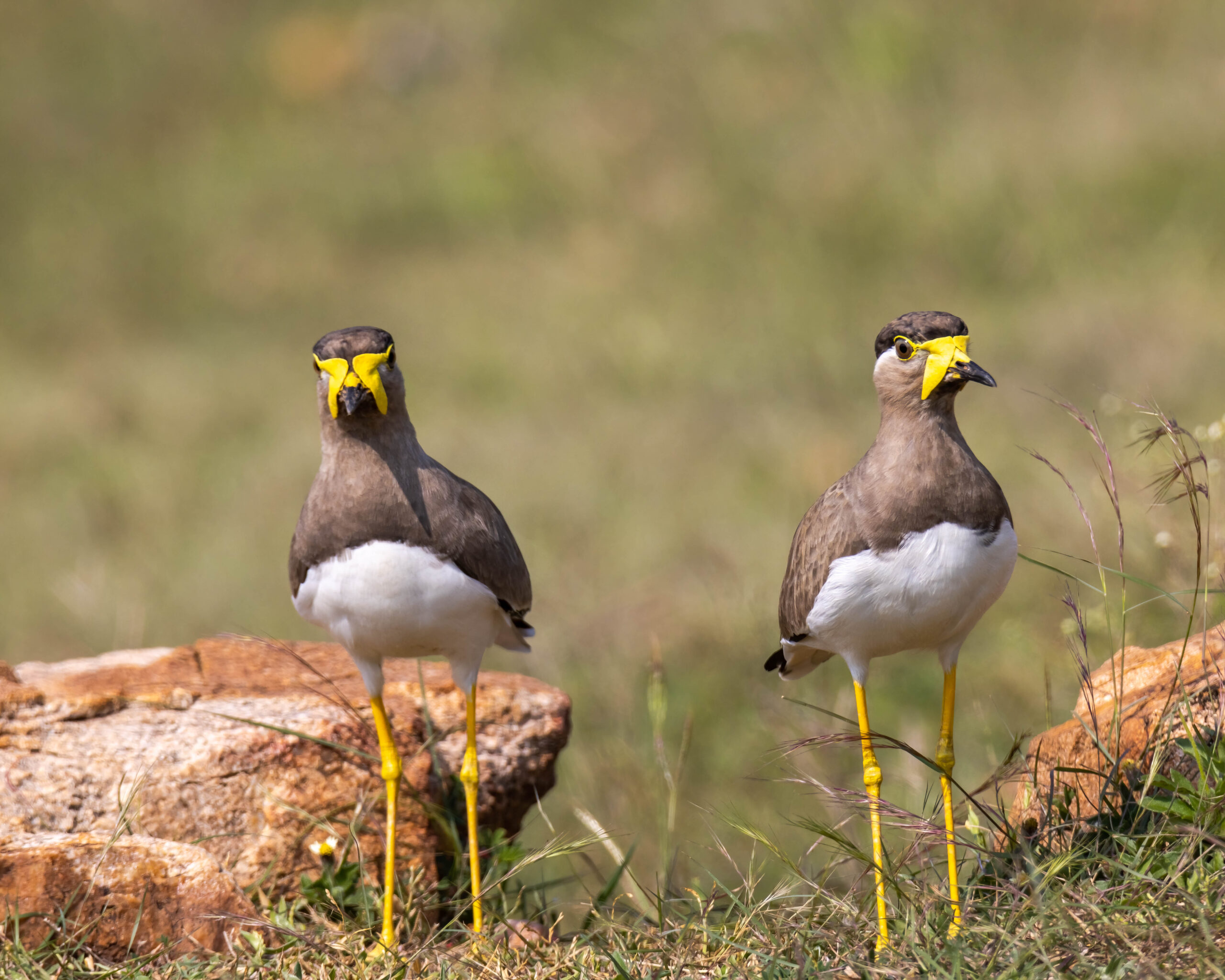
Scientific Name: Vanellus malabaricus
Conservation Status: Least Concern
The Yellow-wattled Lapwing is an endemic bird to the Indian subcontinent. This bird is normally found in the dry plains of peninsular India. It is known to make seasonal movements in response to rains. This is a very rare lapwing of Assam. It is rarely found in Rani Reserve Forest and its surrounding areas during the summer season. Recently there are some records of breeding of this bird in Assam.
-
Zitting Cisticola

Scientific Name: Cisticola juncidis
Conservation Status: Least Concern
The Zitting Cisticola is a small insectivorous bird forages in small groups. This bird is normally found in grasslands. This is one of the widely distributed birds of Assam.
Conclusion
Birds are playing a pivotal role in conservation of the ecosystem. Their importance in pollination, seed dispersal, pest control and nutrient cycling make them an essential species for the survival of the ecosystem. Therefore, protecting bird populations and their habitats is crucial for the well-being of both the environment and the humanity. The above list of 51 most common birds of Assam is a random list.
Bibliography:
Very worthful information.
👍👍👍